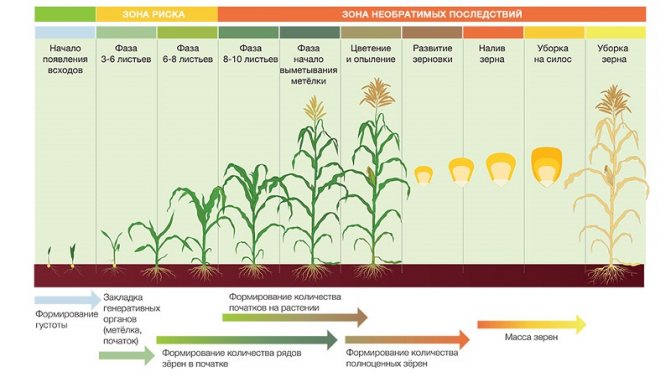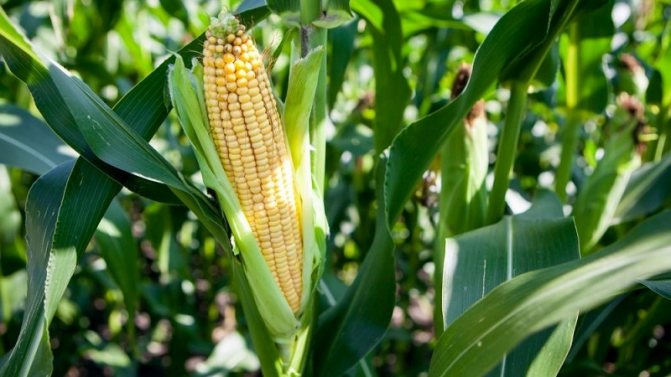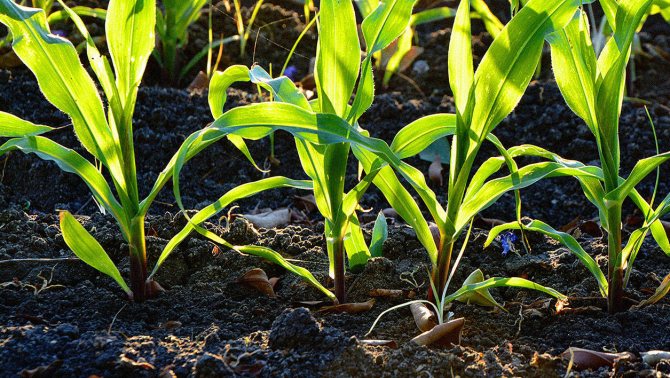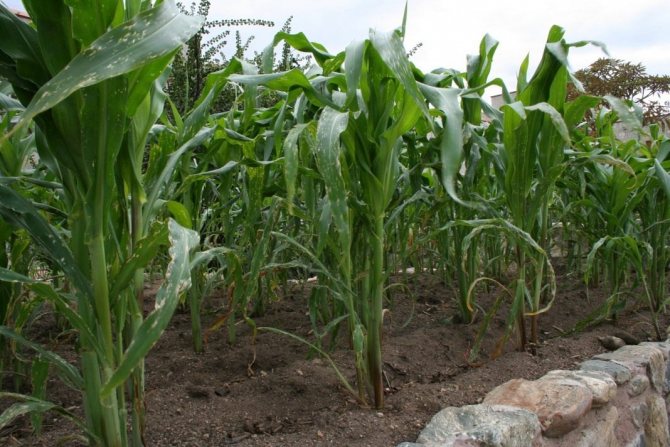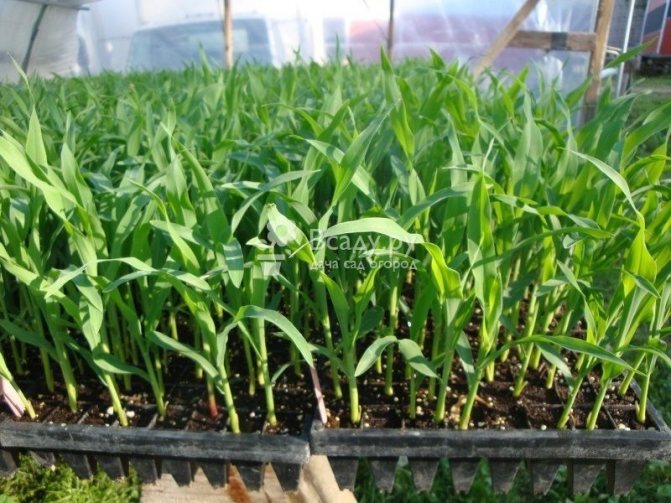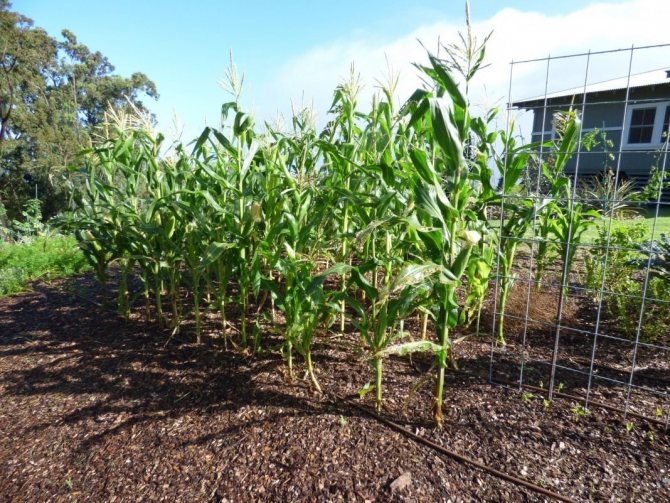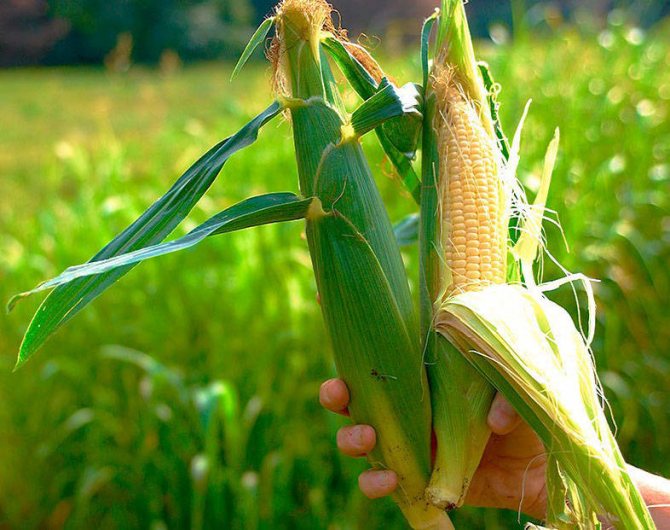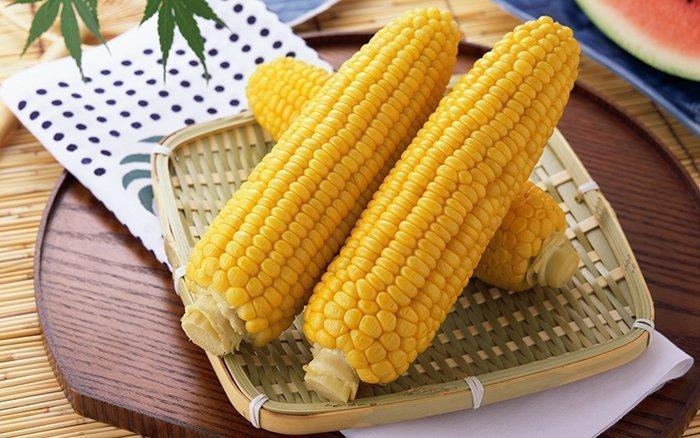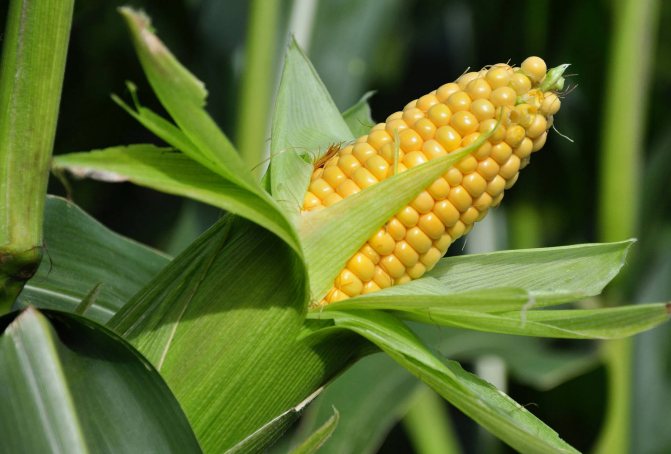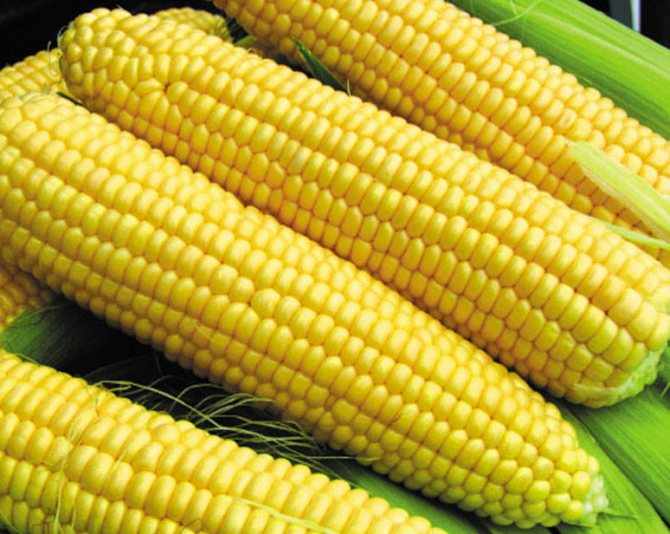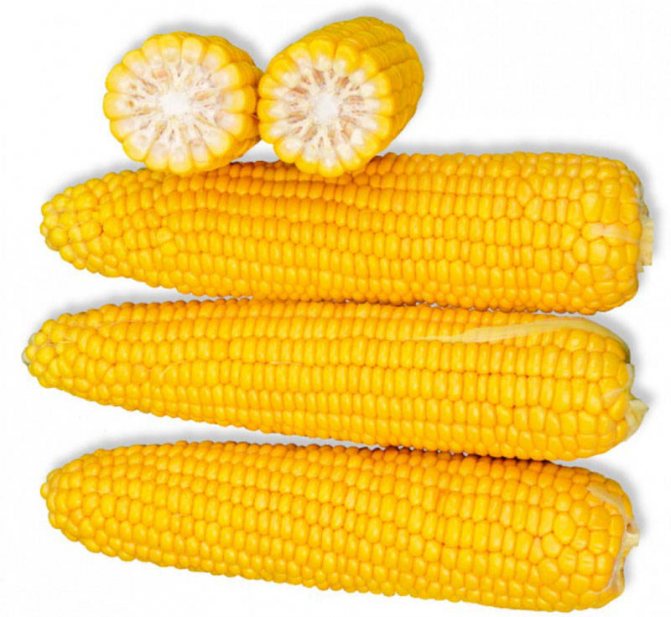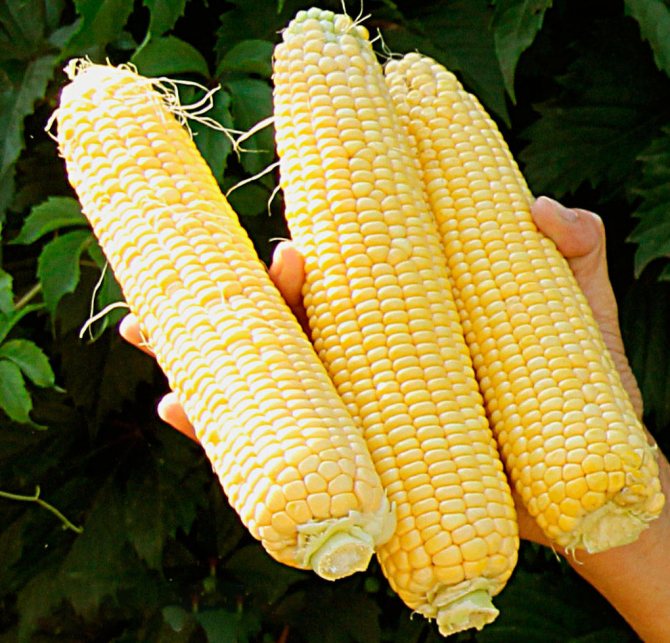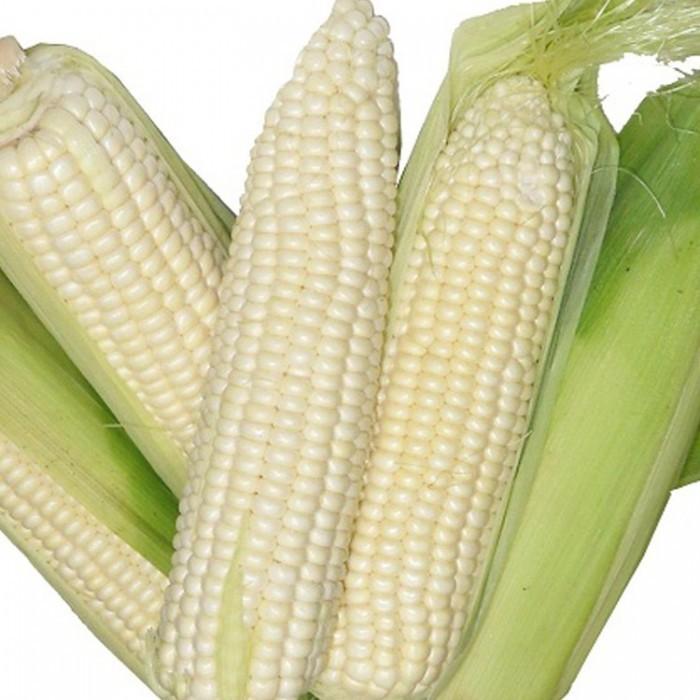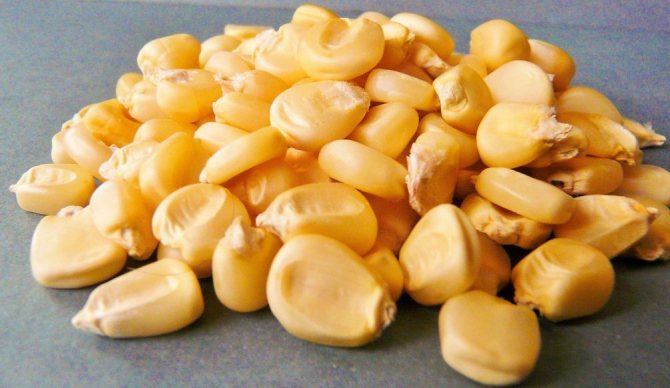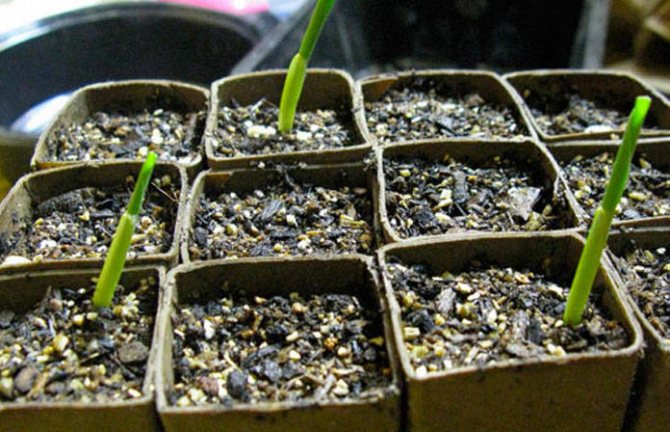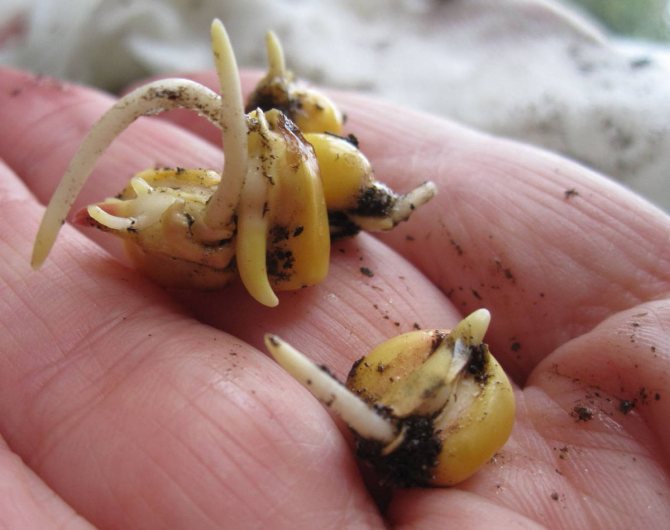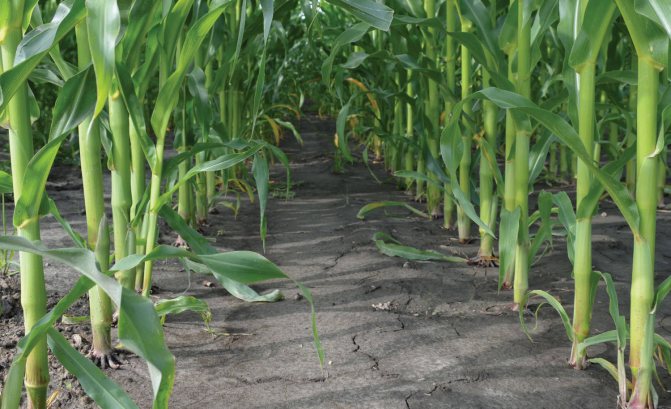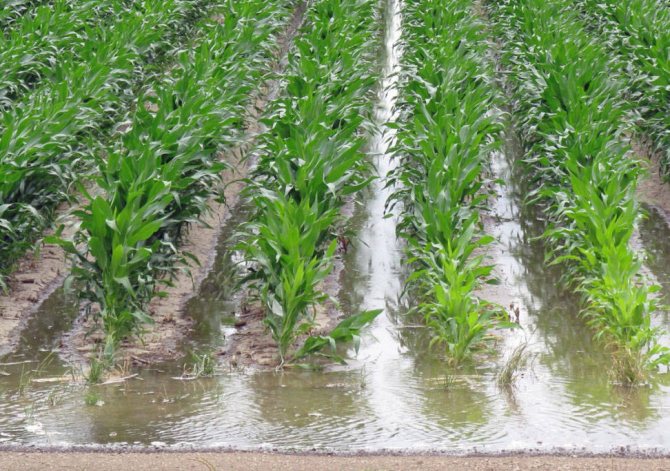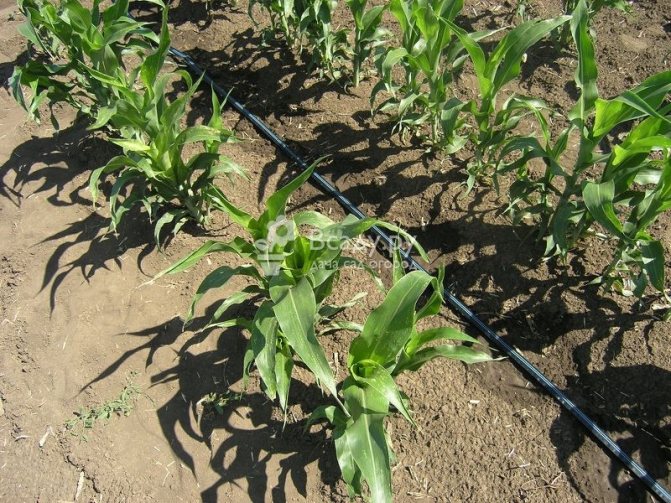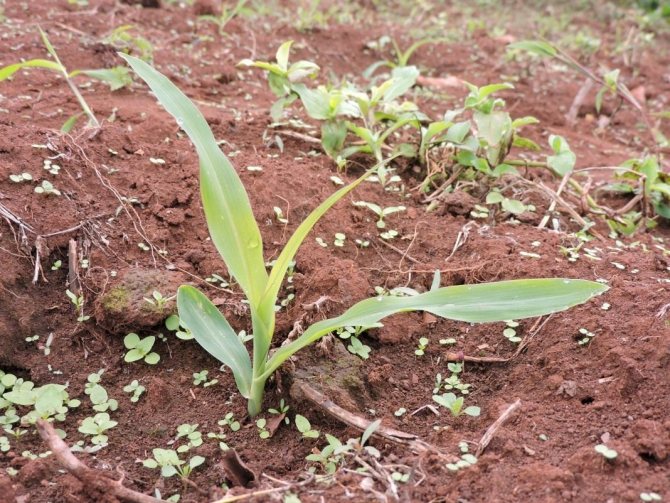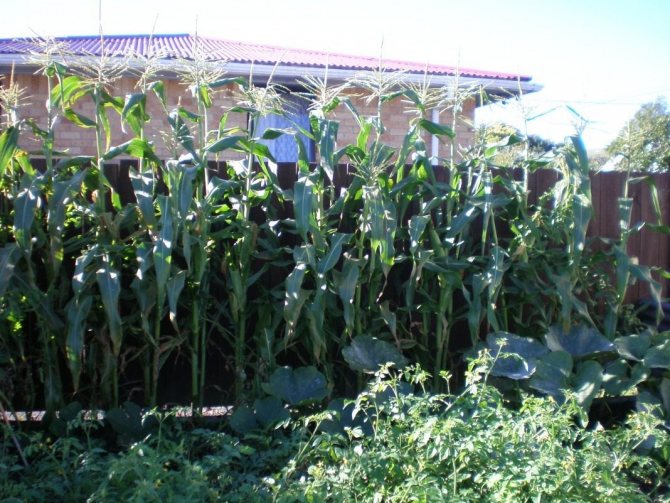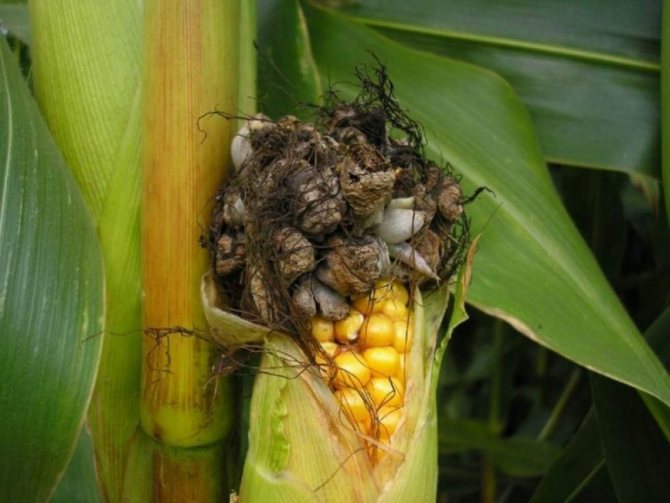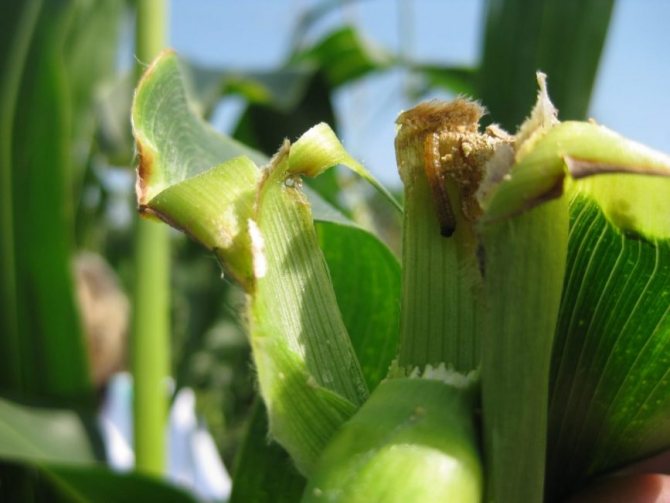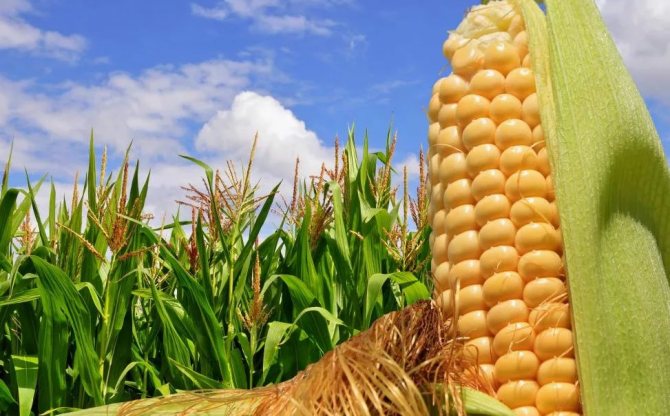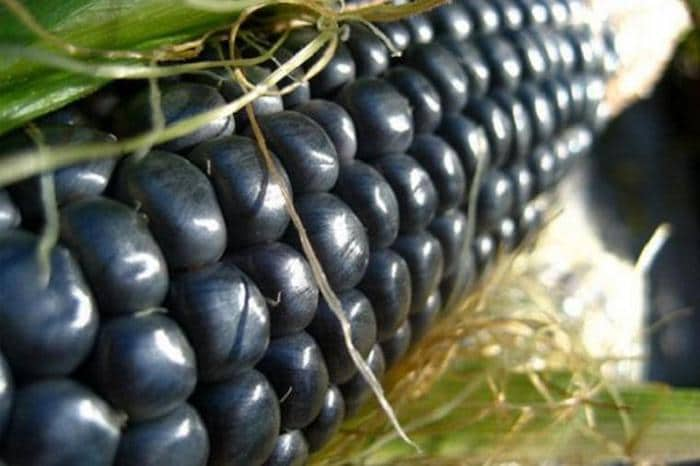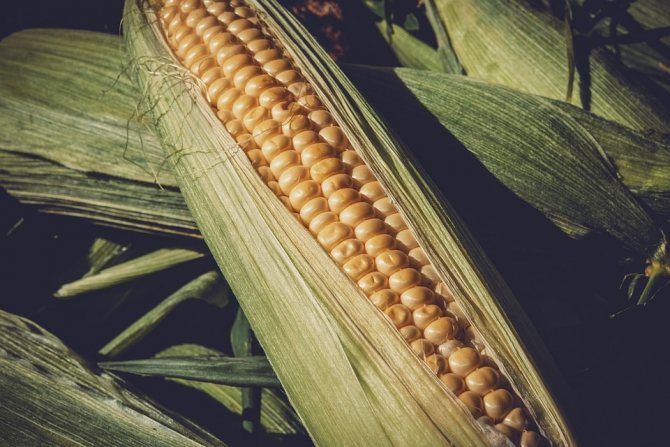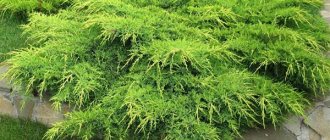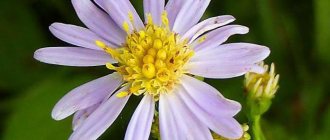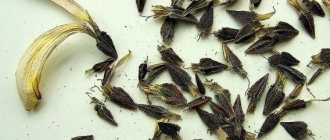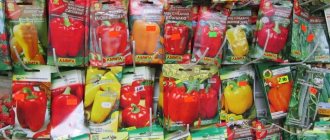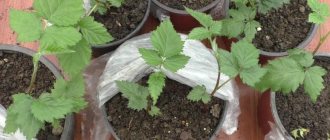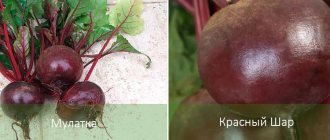The delicate and rich taste of sweet cobs, densely stuffed with juicy grains, yellow, like little suns, have been loved by everyone since childhood. But growing corn on a personal plot seems ungrateful to many gardeners. To collect a generous crop from its bushes, which has reached technical ripeness, you will have to work hard, and first of all, get the necessary knowledge about agricultural agricultural technology.

Healthier and tastier than corn .. only corn!
The plant breaks records for the volume of cultivation around the world. Fruits - the cobs are used for preparing various dishes and preserving, they are also good as an independent side dish. And how pleasant it is to feast on a fragrant boiled ear of corn in the summer!
After drying, the seeds become feed for poultry, or are used for grinding into cereals, flour. Greens are fed to livestock. It is easy to get a unique and useful product by sowing directly into open ground. It is also important to decide on the variety (we will consider the varieties at the end of the article). Timing, planting and grooming principles are universal. This article contains complete information about all the nuances of the correct planting of corn.
When to ripen, or when to pick corn cobs
The upper ear of corn ripens earlier than the rest, growing on a single stalk. They will tilt perpendicular to the stem when all the kernels on the cob are swollen and ripe. When pressed with a fingernail, a thick white juice will be released from the grains, and the threads on the grains will darken and become easily separated. Fully ripe grains change color from milky to rich yellow. The top of a ripe head of cabbage becomes rounded, not sharp. The stalk and leaves of the corn begin to dry out.
The harvesting period for early varieties of corn falls on the end of August - beginning of September. The collection is carried out with gloves, otherwise the hands may be injured. Only ripe ears are picked, the rest are left to ripen. Sweet corn types quickly lose sugar, which turns into starch, so they need to be eaten as soon as possible.
Salads with corn for the New Year. 10 recipes
The popcorn corn is harvested after the stem and leaves of the plant are completely dry. The ears of this corn variety must be fully ripe for the kernels to burst easily. Therefore, the popcorn corn is harvested after all parts of the plant are brown.
For many, sweet corn is the desired product that appears on our tables for a short time, but brings a lot of pleasure and benefits. Corn grains contain many active biological substances and dietary fibers, which are always needed by the human body for normal functioning. You can freeze sweet corn plucked in your garden, and then the memories of summer will return to the house at the moment when a boiled ear, grown with your own hands, appears on the table.
Brief botanical description
Maize is directly related to the Bluegrass or Grain family, the genus is monotypic (consists of a single species). This annual plant is imported from Mexico. Various varieties have been obtained through the efforts of breeders.
Plant height is 1.5-2.5 m.The tenacious roots are perfectly retained in the soil, which prevents the bush from falling even with fruits (only after heavy rains with a strong wind, the corn lays slightly).
Stems are erect, up to 5 cm in diameter, inside the cavity is covered with vascular-fibrous bundles. The leaves are large, belt-like, 1 m long and up to 10 cm wide with longitudinal veins (the central vein is strong and makes the leaf directed upwards). The surface is slightly pubescent, and the edges of the leaves, like a sheet of paper, can leave a cut, so be careful in the thicket of corn. There are 12-23 leaves on the stem in total. During flowering, a panicle forms at the top. Interestingly, the cobs are formed separately on the sides of the stem.
The question of how to plant corn is not difficult to answer. The choice and preparation of the site, adherence to the timing and method of landing are important.
How to care for plants after germination
After the emergence of corn seedlings, they must be watered, weeded and hilled. Plants should root well and develop a strong root system that will give the tall stem resistance. In the first period of growth, watering is carried out as needed - when the soil dries out to a depth of 5 cm.
After watering, the soil should get wet to a depth of 10-15 cm. After 4 true leaves appear on the plant, there is a period of intensive growth of the corn stalk. From this moment on, the number and intensity of watering are increased.
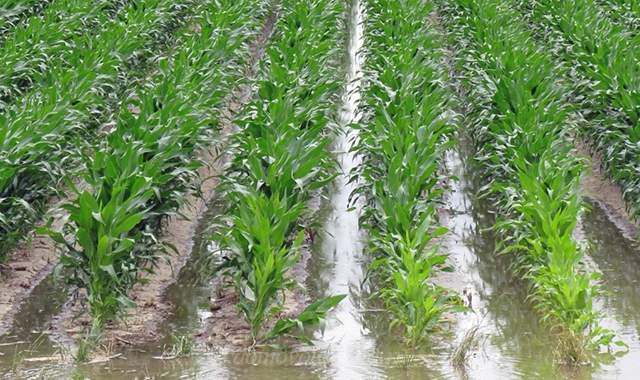

At the same time, it is necessary to carry out nitrogen and other top dressing of corn, if the appearance of the plant shows that it lacks something. Reduce watering when the corn cobs are nearly formed. This will allow more sugar in the corn kernels.
If many stepchildren are laid on the corn stalk, they are removed. This is done with garden shears. At the stage of maturation of the heads of cabbage, the plant requires additional fertilizing: 30 g of a potassium-phosphorus mixture is added per 1 square meter.
Suitable location and site preparation
Illumination
Corn is light and thermophilic. Many people mistakenly think that you always have to tinker with growing seedlings. In the south and in central Russia, corn seeds are directly sown in open ground, the seedling method is necessary for colder regions.
Be sure to choose the site in a sunny place, protected from a draft.
Predecessors
When determining a place for planting, it is important to take into account, and then plant corn. Pulses, grains, cucumbers, tomatoes, and root vegetables are good crop precursors. It is recommended to plant a pumpkin between the rows: with its large leaves, it will protect the root system of the neighbor corn from overheating. Also nearby legumes (peas, beans), which saturate the soil with the necessary element of nitrogen, will not interfere.
Soil composition and fertilizers
Soil requirements for corn: well-drained, loose, nutritious soil, free from weeds and with moderate moisture levels. In order not to worry about the growth, development and high yield of corn, you should worry about the condition of the soil in advance.
- Soil preparation is not done a week or even a month before planting, but even in the fall.
- In order for the earth to become crumbly, it must be loosened to a depth of 25-30 cm. In the garden, you can do this by digging with a shovel manually or with a walk-behind tractor.
- Seal potassium-phosphorus fertilizers on the site according to the manufacturer's instructions and rotted manure.
- If the soil is acidic, add 2-3 kg of garden lime to each square meter (only from autumn).
Loosen the soil again just before planting in the spring. This will remove weeds and oxygenate the earth.
Variety selection
At this point, special attention must be paid, since the entire crop largely depends on the choice of a suitable variety.It is recommended to choose varieties adapted to this region, released for cultivation in this particular climate. So, for the districts of the Moscow region and the middle strip, such a variety as "Dobrynya" is well suited.
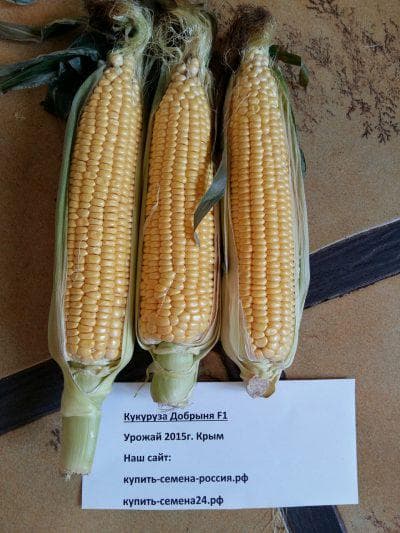

Dobrynya corn
This is an early-maturing variety of corn, distinguished by large ears with juicy, sweet grains.
Very well suited for large areas of the Central Russian plains and such a variety as "Lakomka 121". This corn boasts excellent yields and strong immunity. It will also be useful to learn about how corn for grain is grown.
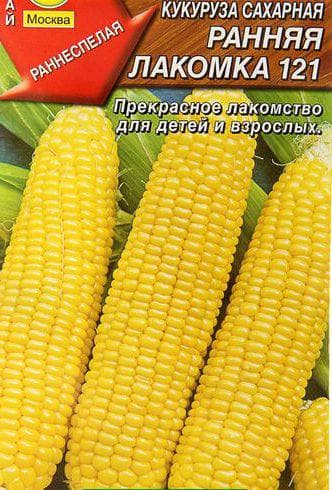

Gourmet 121
Another noteworthy corn variety is Early Gold 401. In this corn, the cobs reach a length of 19 cm, the variety is mid-season.
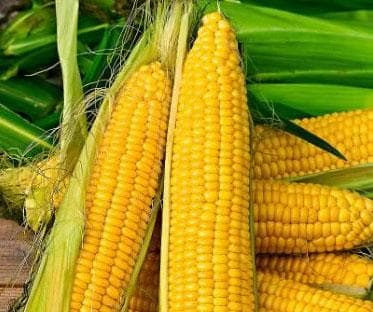

Early gold 401
Today, farmers have the opportunity to choose cold-resistant varieties that can be cultivated even in Siberia. These varieties are usually early maturing, so that they have time to ripen in a short summer.
The most popular early cold-hardy maize varieties include:
- Dniprovsky 247;
Corn Dniprovsky 247 - Bukovinsky 2 and 3;
- Voronezh 76 and 80.
And many gardeners have now switched to hybrid varieties of corn, since the latter are highly resistant to diseases, and, in addition, are extremely productive.
When to plant corn in the ground and for seedlings?
They are engaged in sowing corn seeds in open ground with the onset of warmth, when there is no threat of return frosts and the ground has warmed up to at least +12 ° C. On the territory of central Russia, similar indicators are manifested late April-early May.
To harvest young corn without interruption, you can sow it several times. Those. varieties with different ripening periods are sown at intervals of 2 weeks.
Growing seedlings is necessary for the northern regions. Sowing for seedlings is carried out in early May., and planted in open ground in early June.
Corn in the plant system
In modern taxonomy, corn belongs to the family of cereals (Poaceae). Separated into a separate genus Corn (Zea). How a crop is represented by a species Common corn (Zea mays), subspecies (Zea mays subsp. Mays). In all countries that grow corn in industrial quantities, this species is used as food, technical, and fodder. Later, a separate species / subspecies / variety was identified - sweet corn (Zea saccharata). In different regions of Russia and the CIS, corn has several names. The most famous are whale, maize, Turkish millet, cob.
Do corn seeds need to be treated before planting and how?
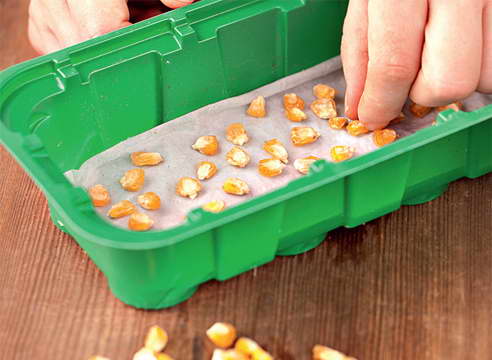

How to prepare corn seeds for planting photo
In order for seedlings to appear in a few days, the seeds need preliminary heat treatment and soaking. For 5 days, it is useful to reheat the grains at a temperature of +35 ° C (by the way, you can skip this step if you are not sure that you will do everything correctly).
Then the seeds are soaked in warm water for about a day (you can just overnight), so that the water covers the seeds only a couple of millimeters. If a longer period is required (for 2-3 days, if we say, it suddenly started to rain and could not plant) - the water must be constantly changed. However, remember: preparing seeds can be harmful, because inexperienced gardeners simply spoil the seeds by overheating or overexposing them in water.
Let's face it, corn will sprout anyway, without soaking, though not so quickly (in two weeks, if it is warm and damp in the ground).
In addition, if you soaked the seeds and plant them in dry soil, there will even be harm: the embryos may die from a lack of moisture. So if soaking, make sure the ground is damp when planting.
Chemical composition of corn
Corn seeds contain B vitamins, nicotinic and pantothenic acids, starch, fatty oil, zeaxanthin, quercetin, flavonoid derivatives. Corn oil is high in vitamin E (the vitamin of youth). It is used in dietetics. In terms of its choleretic properties, it approaches the properties of egg yolk. Corn oil lowers cholesterol levels. Used to prevent atherosclerosis.
Corn silk is especially rich in useful properties. They contain bitterness, chlorophyll, glycosides, saponins, flavonoids, and gums. Resins, vitamins of group "B", "K", "E", "D", ascorbic acid and other compounds. Preparations from corn silk are used in official pharmacology in gynecology, for Down's disease, kidney disease and other diseases.
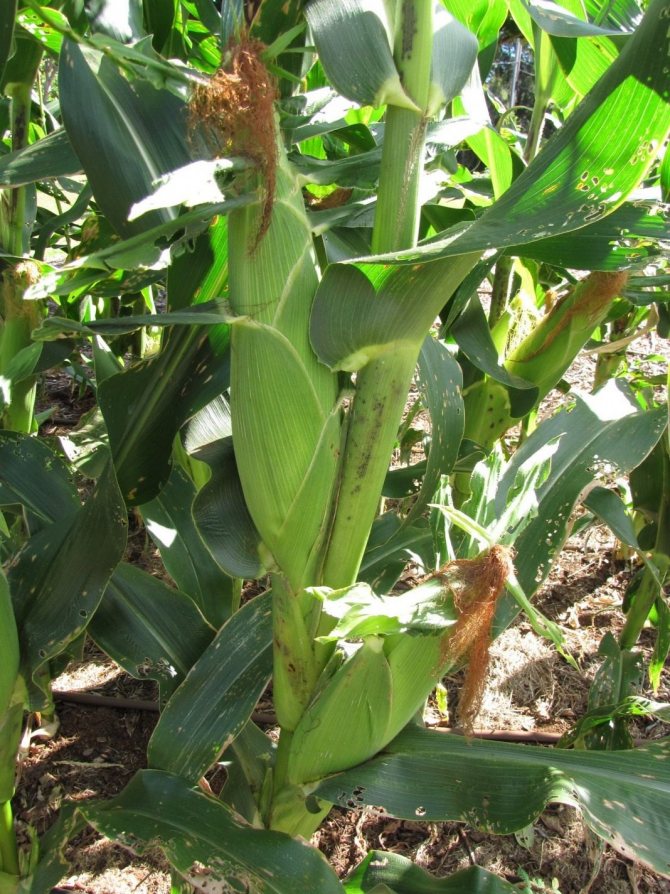

Sugar corn (Zea mays).
How to plant corn with seeds in the ground
After preparing the seeds (or without it), we proceed to the sowing process itself. The most successful in home planting is the method in which the seeds are planted in holes in 2-3 pieces. The ideal embedment depth is 5-7 cm.
- Planting corn is very simple: take a hoe, make a hole up to 10 cm deep, drop the seeds, and push the soil back into the hole with your foot, pressing lightly. Everything!
- Leave the distance between the rows at least 70 cm (or preferably a meter), so that later it will be convenient to walk along them when the plants are taller than your height.
- The distance between holes in a row can be reduced by leaving about 40 cm.
You can also plant curly beans in the corn hole (2 seeds each). So you get the double benefit of an additional bean crop plus the enrichment of corn with nitrogen, because the bean contributes to this thanks to the beneficial bacteria located at its roots.
After emergence, leave one of the most developed and viable sprout (some gardeners leave two, but the plants will not be as powerful). Also, corn is sown in the grooves formed by the walk-behind tractor. Germination lasts 2 to 14 days, depending on the weather and seed preparation.
Sowing corn on the beds
Planting corn with seeds is a simple and quite effective way of growing a crop. Its terms are determined by the peculiarities of the local climate. To get friendly shoots, corn grain is sown when the weather is warm and the threat of frost has passed. The thermometer should not fall below 10-12 ° C during the day. In Siberia, you can start planting corn closer to mid-May.
The result will be better if the seeds are prepared before placing in the ground. Professionals advise to soak them. There is nothing complicated in this procedure, for it you will need:
- a piece of gauze, burlap or any other fabric;
- some wood ash;
- the corn itself.
Seeds must be soaked according to certain rules. The fertilizer is thoroughly dissolved in water heated to 22-25 ° C. Then, corn seeds are dipped into this nutrient composition. They do not keep them in it for a long time, 12 hours is enough. An envelope is made of gauze, it is abundantly moistened with a prepared solution and the planting material is placed in it. The condition of the seeds will be checked daily to ensure they are supplied with oxygen. If they have not yet hatched, they are mixed, if necessary, moistened and covered with gauze again. Finish these manipulations when the first shoots appear.
Sprouted corn grain is placed in a slightly loosened soil, having previously marked grooves in the garden, the interval between which is made equal to 0.5-0.6 m. At a distance of 40 cm from each other, holes of medium depth (6-7 cm) are dug in a row. 3-4 seeds are laid out in them. The square-nest planting scheme is optimal for maize: with this arrangement, self-pollination is successful in adult plants and the yield increases. Then the hole is filled with wet soil, and a layer of dry earth is poured on top as mulch.
Sweet corn springs up pretty quickly.If the seeds are soaked, then young shoots will appear in 10-12 days. If you do without preparation, you will have to wait 5-7 days longer. When corn sprouts appear from the soil, only one more powerful one is left in each of the planting holes, and the rest are pulled out.
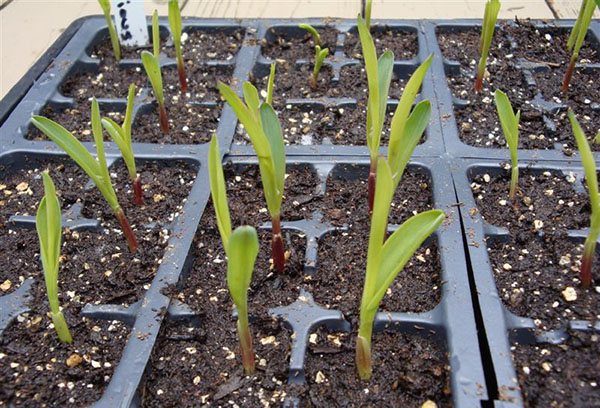

Growing corn seedlings
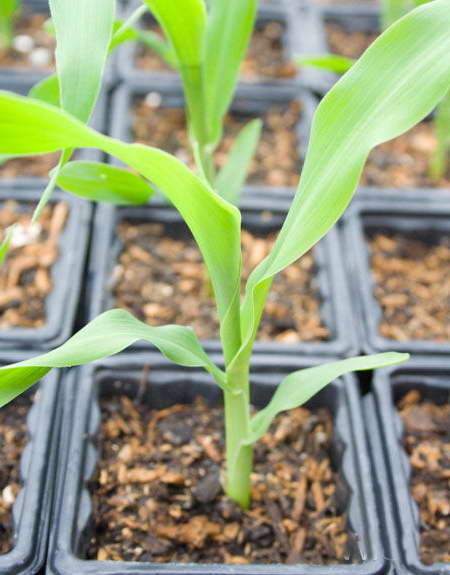

Seedling corn photo
For the cooler northern regions, growing corn in a seedling way is relevant. A similar method can also be used to obtain an earlier harvest. The process begins with the preparation of containers and substrate. Special cassettes or individual cups (paper, peat, plastic) are ideal. The soil mixture is prepared from two parts of compost, one part of sand, one part of peat and a small amount of wood ash.
- Sow seeds one at a time, planting 2-3 cm deep.
- Grow at normal room temperature, maintain bright light, and water sparingly without stagnant water.
Plant corn seedlings in open ground by transshipment. Keep the earthen lump intact, only embed it into the soil 3 cm deeper than the seedlings grew. After planting, watering is required and preferably mulching with humus, cut grass, etc.
How to deal with pests
It is not only the typical pests of garden plants - aphids, wireworms, corn moths and beetles - that cause harm to corn. The birds love to feast on young seedlings and ripening corn. Chemical means of control, such as "Aktelik", "Karate", "Zeon", "Cruiser", bioinsecticides "Aktofit", "Bitoxibacillin" will help in the fight against small insects.
On large cultivated areas, birds are scared away with the help of chemical repellents. These include highly toxic Vofatox and Avitrol-200. Poison baits are spread in small quantities. The few birds that eat them start screaming and convulsing. The rest of the birds fly away when they see these signals of trouble. But in a small garden it is more humane to install old grandfather's scarecrows or hang multi-colored flags.
How to deal with cotton budworm in corn
Almost everyone who has grown corn knows about the cotton bollworm. But how to deal with it, you can learn from the video.
Diplodiasis of corn
What is this disease, and where can it come to us? How to recognize and deal with dry rot.
Outdoor corn care
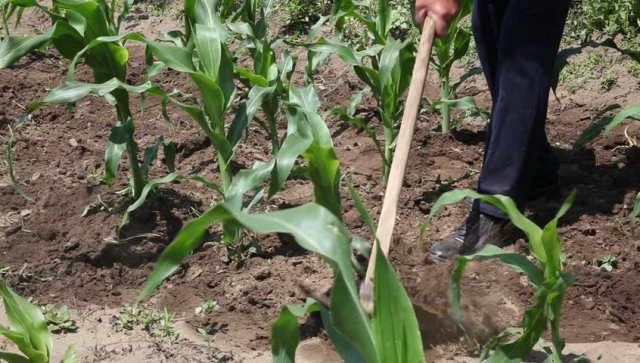

How to care for corn outdoors
It is not enough to know how to plant corn to get a harvest; the plant requires proper care.
Loosening the soil, weeding and hilling
An important maintenance measure is weeding, loosening and hilling, which are carried out in order to control weeds and give resistance to plants. When planting at home, this is done manually, and on an industrial scale, machines are used. The stalk of the corn is thick and the plant itself is large, so the procedure will prevent lodging from rain and strong gusts of wind. Also, hilling promotes active growth; in hilling plantings, the optimal level of moisture remains longer.
Top dressing
Provided that it is planted in a pre-fertilized area, there is no need to feed the corn. Otherwise, at the stage of forming a bunch of 6 leaves, it is advisable to apply liquid fertilizers, which will significantly increase the yield of corn (yes, this is an unpretentious plant that yields almost no maintenance, it can be several times more!). Apply a solution of infusion of mullein or chicken droppings. Of the mineral fertilizers, ammonium nitrate, nitrogen and potassium phosphate are suitable.
It is recommended to water the corn during the ear-laying period. In the future, with a strong drying out of the soil, it is useful to moderately moisturize the site, avoiding stagnation of moisture.
After landing
It takes little for sweet corn to produce a rich harvest.Planting care includes:
- watering;
- top dressing;
- loosening the soil;
- hilling;
- weed removal.
Sweet corn loves clean beds and light, porous soil through which its roots can breathe freely. It is especially important to follow these rules at the initial stages of the development of its bushes. During this period, loosening is indispensable, but they are stopped as soon as the adventitious roots are formed in the corn. Then the time comes for hilling, which will make the bushes more resilient. They will need to be completed at least 1-2 times per season.
Corn on the backyard is closely monitored, removing weak shoots and stepsons from the bushes. It is not worth breaking them out, there is a safer and less traumatic way to the stem - carefully cut them with scissors. If this is not done, they will take away the strength and nutrients from the corn, which are necessary for the grain to be poured and ripen on the cobs. The formation of numerous stepchildren is a reason to think about whether the watering of the beds is carried out correctly. This is how sweet corn most often reacts to a lack of moisture.
But an excess of water will not benefit the plants: depriving the flow of oxygen, their roots may die. Determining waterlogging is easy. The leaves of the corn take on a purple hue and the development of the bush slows down. As a result, the plant is dwarf in size, and its ears do not fully ripen.
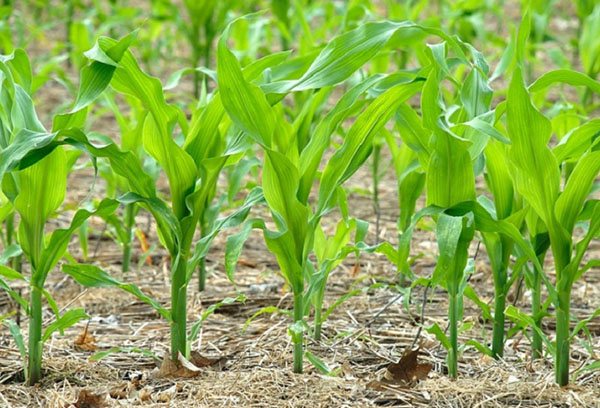

Harvesting corn
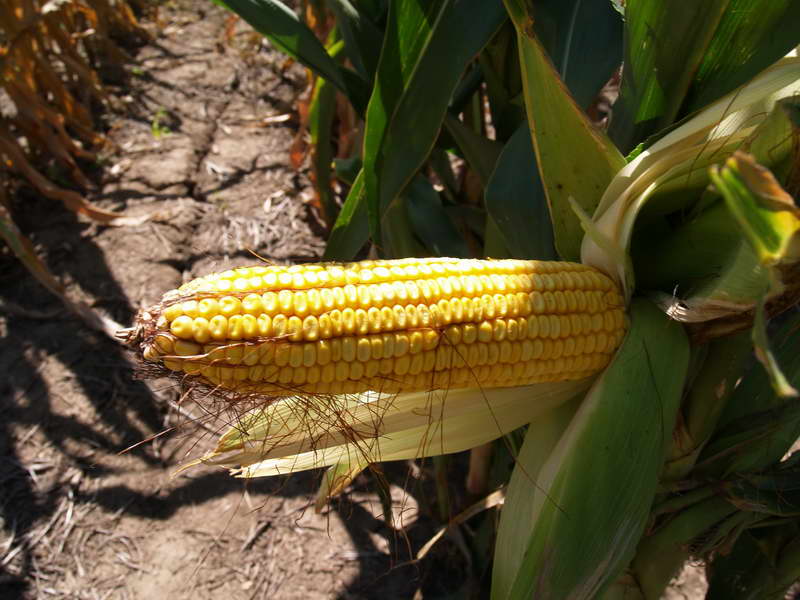

When to harvest corn
You already know how to plant and care for corn. It remains to learn about the harvest. It all depends on the end use.
The cobs for cooking or preserving the kernels are harvested at the milk ripening stage. In such plants, the tips of the panicle are darkened, the tassel of the cob can wither, and the leaves on it are separated with difficulty, the grains are soft, light yellow.
But corn for grain or for popcorn is harvested at the stage of full biological maturity. At this time, all the leaves will turn yellow, the grains will acquire hardness and orange color, the brush will dry out.
There are no strict rules for harvesting corn. Experienced gardeners only give some recommendations. You should not pluck all the ears from the bush at once, usually the collection starts from the top, because they mature faster. The ear, together with the leaves on it, is completely broken off from the stem, cleaned and sent for sale or storage (for grain). In the latter case, they are dried in a ventilated place and kept out of the reach of rodents.
Medicinal properties of corn
Grain and female corn inflorescences contain an extensive list of nutrients and vitamins that have a healing effect when used in food or in the form of medicines.
Harvesting female flowers of corn promotes the expulsion of bile, regulates the activity of the pancreas and liver, gastric and intestinal motility. There is a positive trend in atherosclerosis, poliomyelitis, eczema, gout, muscular dystrophy, hypovitaminosis "E" and other diseases.
Medical fact. Aborigines of the countries of the "corn belt" practically do not get cancer.
Diseases and pests of corn
On the way to obtaining a harvest of such a wonderful cereal, diseases and pests can arise. You should be able to recognize them, know the methods of prevention and control.
Diseases:
Fusarium
Pathogens (molds) are stored in the soil and on plant debris. Immediately after germination, the sprout turns brown and dies off. The disease may appear later: the surface of the weevil is covered with a gray or pinkish bloom. To prevent the situation, sow only treated seeds in well-heated soil, and in the fall, remove plant residues from the site.
Dusty smut
An infectious disease characteristic of the southern growing regions. In this case, its pathogens remain in the soil for a long time, since they do not freeze. The affected panicle turns into a dusty, loose mass, and the ear turns into a solid black lump.It is necessary to adhere to crop rotation, remove plant residues from the soil.
Bubble smut
The plant is affected by a special fungus from which gray wrinkled growths appear on the cobs, panicles and leaves. They fall off and remain in the fields, which is why regular contamination occurs. The cause of the disease is drought and heat, planting density. For sowing, select only healthy ears, dressing the seeds if necessary.
Stem rot
The disease is inherent in regions with a humid climate. Closer to the lower part of the stem and on internodes, dark spots appear, soon the areas soften and the plant becomes brittle. Treat the seeds, stick to the crop rotation, fertilize the soil.
Rust
On the back of the leaves, yellowish stripes appear, spreading spots, from which the bush quickly dies off. Sugar varieties are the most susceptible to disease, so choose proven, resistant hybrids. After harvesting, carefully dig up the area, select healthy seeds and process them before sowing.
Southern helminthosporiosis
First, the leaves are covered with brown and gray spindle-shaped spots, then a sooty bloom forms in their center. The cob leaves also cover the dark formations, then the seeds rot. With the first signs of damage, it is better to immediately remove the plant from the site.
Maize pests:
Root aphid
Greenish bugs eat away plant tissues and the bush dies. Use insecticides.
Swedish fly
Its larvae are in the ground and are capable of infecting young seedlings. The leaves do not unfold well, holes and breaks appear on them. Autumn plowing is required. Make crops thick to remove the diseased sprout. As a last resort, use an insecticide.
Corn moth
Gluttonous larvae gnaw on leaves, a stem, and also the first ears. The leaves of the plant turn yellow and break. It is important to dig up the soil in advance and sow the treated seeds.
Scoop
First, they damage the leaves and bite into the cobs. In order to protect it, it is important to destroy the remains of plants and weeds in the fields, and to plow the soil deeply.
The best varieties of corn seeds
Thanks to the work of modern breeders, such a heat-loving crop as corn began to ripen not only in the southern regions of Russia, but also above the borders of the Moscow region. For this to happen in practice, high-yielding, early-maturing, disease-resistant hybrids and maize varieties must be selected.
Early sweet corn hybrids mature 75-80 days after the seeds are planted in the soil. These include Trophy F1, Jubilee F1, Landmark F1. The length of the ears of these plants is from 21 to 23 cm, the grains are sweet and juicy.
Mid-season hybrids are resistant to adverse weather factors, but they do not tolerate frosts well, therefore they are recommended to be grown through seedlings. At the same time, in terms of their taste and other consumer qualities, later types of corn are not inferior to early hybrids. Corn "Polaris F1" ripens in 105 days, is resistant to lodging, the length of the cob is from 24 cm. The hybrid "Sweetstar F" grows up to 2 m in height, has amber-yellow aromatic sweet grains, is not susceptible to disease.
The late-ripening hybrid "Bashkirovets" ripens in 140 days, is demanding on feeding. Corn of this type has large grains, the weight of one ear reaches 350 g.
For the preparation of popcorn, cold-resistant corn "Oerlikon" is grown. Its ears are ready to use in 105 days. For the same purposes, grains of the early ripening (up to 75 days) variety "Vnuchkina Joy" are used. The variety has small ears 10-11 cm long and weighing up to 230 g.
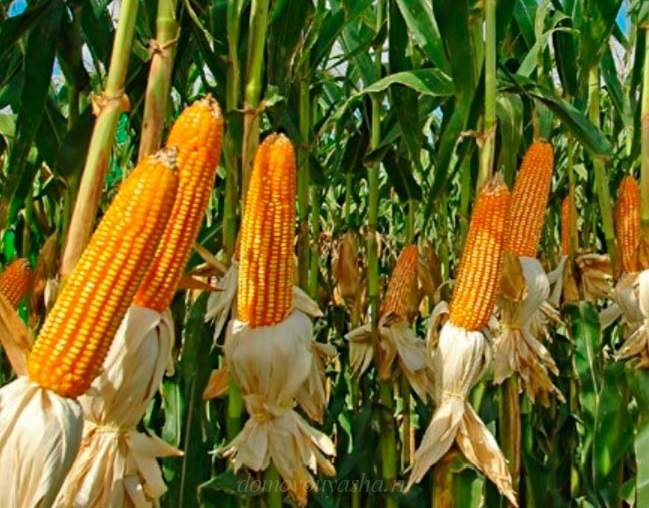

What kind of corn is better to plant
There are many old and new corn varieties. Every year, new hybrids appear, adapted to various weather conditions, including unfavorable ones.It is known from the experience of many farmers that the later varieties proved to be the most productive.
Find out what are the average corn yields per hectare.
But they are not suitable for regions in which autumn colds and frosts come early, therefore, for planting in your garden, it is best to choose one of the zoned varieties that are bred specifically for this area. It is also worth considering that sweet corn varieties are more whimsical to care for than fodder ones.
The main criteria for choosing the right corn variety:
- adaptation to local conditions;
- purpose of use: in cooking or as animal feed;
- ripening: early, middle or late;
- resistance to pests and diseases;
- frost resistance;
- unpretentiousness.
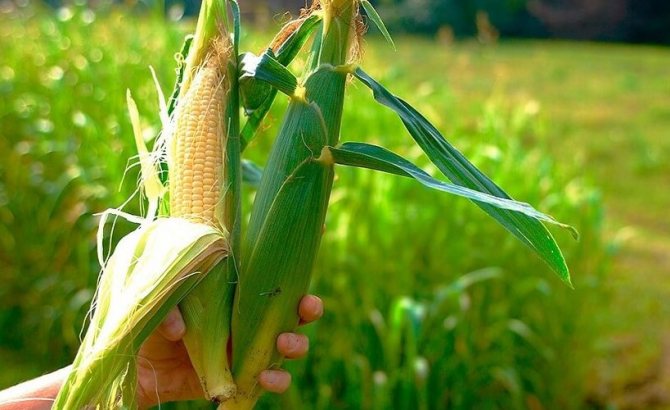

Here are some of the varieties that meet the listed criteria:
- Swift - a low early ripening variety with very sweet grains;
- Suite 77 - a large mid-season variety, very sweet;
- Sundance - early maturing corn, suitable for northern regions, with large ears;
- Triple sweetness - unpretentious and very sweet;
- Honey Bentham - early ripe two-color variety.
Did you know? The Mexican word "tlaolli" ("corn") literally translates to "our body." This name is associated with the Aztec myth, according to which, the corn god Centeotl was chopped up by another envious god, and his body parts became corn cobs.
Tips and tricks from experienced farmers
The following tips and recommendations will help novice gardeners in growing healthy cereals:
- Harvesting begins at a grain moisture content of 70-75%. If dimples form on the top of the grains, then the humidity has decreased to critical values.
- Immediately after harvesting, the long stems of the cobs and stipules are removed - they draw moisture from the grains.
- After harvesting, the ears are used for food or canned as soon as possible. Grain quickly loses sugar and delicate taste.
- At zero temperature and 90% humidity, the ears are well stored for about a week. If the temperature is higher, for example + 5 ° С, the storage period without loss of quality is reduced to 3-4 days, at + 10 ° С - up to two days.
- The roots of young shoots are located close to the soil surface, therefore, be careful when loosening and weeding.
- It is good to plant corn next to beans, pumpkin, cucumbers. With its wide leaves, it shades the soil, inhibits the growth of weeds and the evaporation of moisture. The powerful corn stalks support the climbing beans, which in turn enrich the soil with nitrogen.
What does corn need?
A tall and powerful cereal needs sun, moisture, nutrition and the right predecessors for successful development and high-quality fruiting:
- Corn will like to grow after melons (pumpkin, zucchini, squash or cucumber), tomatoes, as well as beets and turnips.
- Find a sunny spot for your cereal, where it will be illuminated for most of the day.
- Corn loves the soil light, well warmed up and optimally moistened, and it will not be comfortable to grow in clayey lowlands.
- The bed on which the corn will grow should be fertilized in autumn with rotted manure and mineral fertilizers.
It is advisable to sow corn in places protected from the wind - on the south side of the fence or outbuildings, so that strong gusts do not break tall stems.
And the result
So, let's summarize all the important points regarding the question of how to plant corn in the country:
- for this cereal, it is necessary to choose a sunny place on light soils;
- for planting in the middle lane, it is advisable to acquire early and mid-season varieties;
- corn can be planted as seeds directly in the ground or seedlings can be grown for subsequent transfer to the beds;
- the cereal needs abundant watering during important growing periods;
- mulch the beds to retain moisture in the soil, avoid weed dispersal and traumatic loosening;
- per season, one organic and one mineral dressing is applied to the corn beds.
By adhering to these recommendations, you can get a high-quality and plentiful harvest of sweet corn. You can boil the fragrant ears and collect bright grains from them to preserve, freeze or dry.
How to plant corn: photo
Corn - benefits and harms
Before planting corn, it's worth figuring out - is it possible for you at all? After all, if a lot is known about the benefits of this cereal (yes, corn is not a vegetable at all!), Then contraindications are often forgotten, although there are some.
So, the benefit of corn is that its grains contain vitamins of group B, E, H, calcium, magnesium, phosphorus, potassium, sodium, iron, iodine, etc. It has a beneficial effect on the work of the intestines, has a choleretic effect, and helps to normalize metabolic processes in the body.
But the disadvantages of corn boil down to the fact that during the period of exacerbation of gastrointestinal diseases, it can aggravate the situation and is contraindicated for people with thrombosis, thrombophlebitis and increased blood clotting.
Growing corn as a business
Growing corn is a profitable business... Culture is in great demand. Canned golden grains, make them flour, butter, flakes, popcorn. Corn is used in the preparation of feed for livestock, for industrial purposes: in the production of alcohol, paste, plastic, plaster, filters. Moreover, they use not only grains, but also foliage, stalks and wrappers of the cobs.
Culture grows well at an average temperature of + 25 ° С... At high rates - above + 32 ° С - the yield decreases. Also, plants are demanding on sunlight. Daylight hours should be at least 12 hours.
The Krasnodar Territory is considered the leader in corn cultivation. Quite good yield in the Voronezh and Belgorod regions. The lion's share of the crop is used for animal feed, the rest is used in the food industry. About a quarter of the harvested corn is exported.
Favorable precursors for cereals - legumes and pumpkin plants. In autumn, the land is plowed, top dressing (manure) is applied. Potash and nitrogen fertilizers are added in the spring.
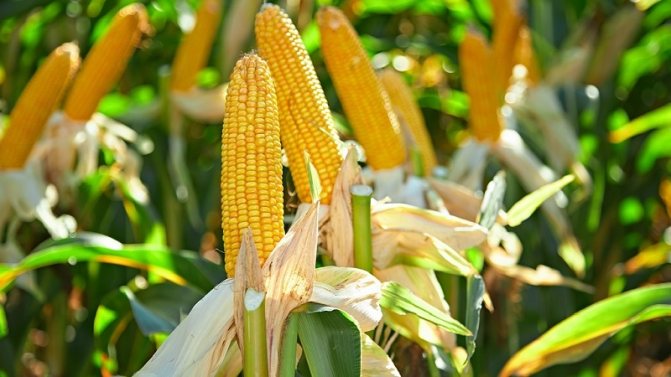

If you planned to plant 56 thousand plants per hectare, then 4.3 grains are needed per 1 running meter. Further, depending on the weight of the grains, the number of kilograms per hectare is calculated. For example, if the weight of 1000 grains is about 200 g, then to sow a hectare, you will need 11 kg of seed. Thus, the cost of seeds will be about 30 thousand rubles.
The cost of renting land ranges from 1,500 to 5,000 rubles. Plowing one hectare of land costs about 4000 rubles. A corn seeder is rented or bought. The price of the unit is from 500 thousand rubles. up to 1.5 million rubles.
To control pests, plants and soil are sprayed with chemicals. Drip irrigation is used as irrigation. Average rate of water consumption is 35 m³ / ha.
Harvesting is carried out in the phase of milk ripeness. The later you harvest, the more starch and less sugar there will be in the grains.
The total cost of wages, equipment, fertilizers will amount to approximately 60-70 thousand rubles. The yield per hectare is about 85 thousand ears when 60 thousand plants are planted. Profitability reaches 700%... This is one of the highest rates in agriculture.
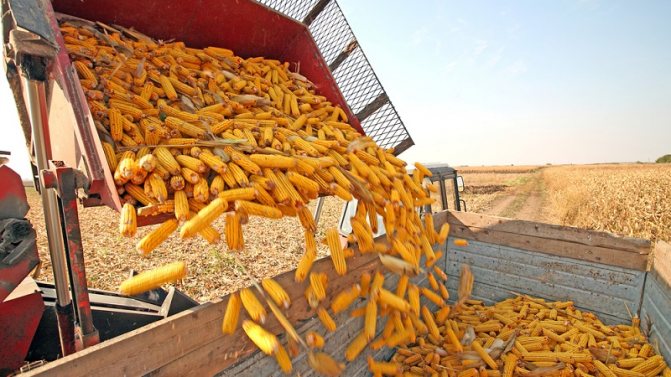

Maize harvesting, storage and freezing
You can determine the ripeness of the crop by the following criteria:
- the leaves on the wrapper of the cobs have dried up, acquired a light green tint;
- the threads have darkened and dried;
- the seeds are smooth, and their rows are tightly closed.
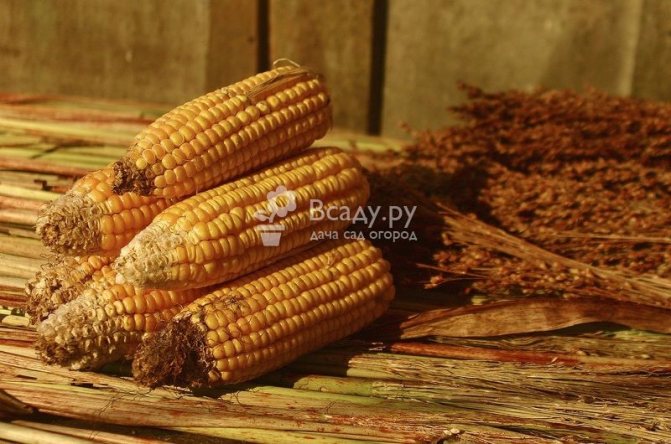

Preparing the corn crop for storage
The leaves are lowered from the cobs, but not cut, the threads are removed. Then the crop should be dried. The ears are woven into braids with leaves and hung on a ventilated veranda.If the seeds fall out with gentle shaking, drying is complete.
Grains are stored in glass and plastic containers, or cloth bags. It is recommended to store dried popcorn corn seeds in the freezer.
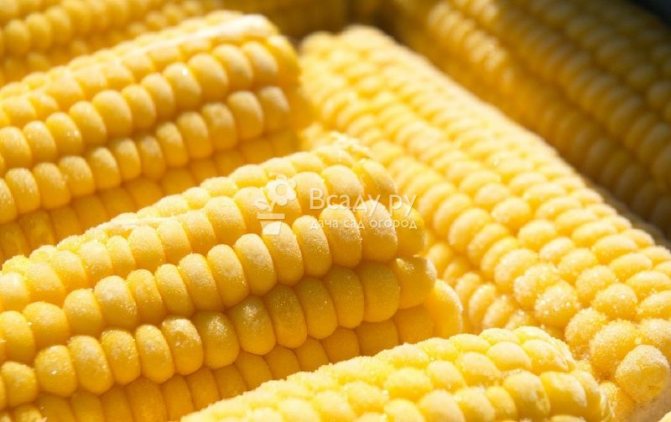

Frozen corn can be stored in the freezer for a long time.
Fresh ears are kept in the refrigerator for just a couple of weeks, and freezing will extend the shelf life up to 1.5 years:
- prepare containers with boiling water and ice water;
- first place the ears in hot water for a few minutes;
- then refrigerate in ice cold;
- dry the ears with a paper towel, and wrap with cling film;
- place in the freezer.
How much corn grows
Corn is an annual herb of the Cereals family. Its growing season lasts 3 to 5 months, depending on the variety. Powerful erect stems can reach 3 m or more. Caryopsis seeds ripen at the end of the shoot.
Fresh articles for gardeners, gardeners and florists
Seed treatment with phytosporin before planting
Tomato varieties resistant to late blight for open field
Pepper seedlings at home without picking
Seed treatment with hydrogen peroxide before sowing
They are rather large, rounded-cubic, tightly pressed against each other, collected at the end of the shoot in the so-called cob. Seeds grow in even rows, each ear can contain up to 1,000 caryopses.
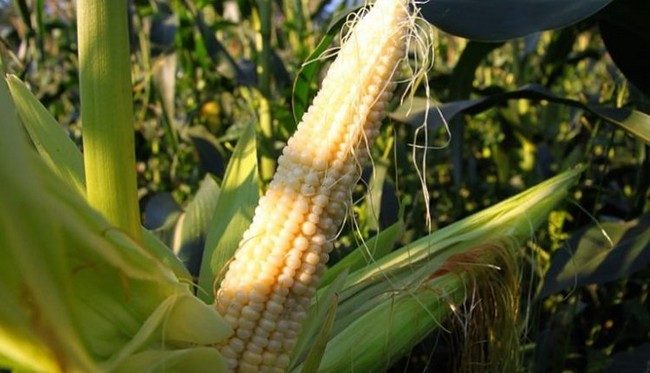

What can be planted next to corn
The space between adjacent plants can be used to grow other plants, such as beans. Peas will feel good in a corn field, high stalks will serve as an additional support for it. For the same reason, you can plant corn next to cucumbers. This method is a good alternative to growing cucumbers on trellises. Grow well next to corn pumpkins and zucchini, as well as potatoes.
Tall plant stems give a fairly strong shade, so light-loving crops next to them will systematically lack solar energy. This will oppress them. It is not recommended to plant the following plants next to corn:
- beets;
- celery;
- white cabbage and cauliflower;
- sweet and bitter peppers;
Tomatoes also do not tolerate the neighborhood with corn. This culture is a pronounced selfish, therefore it is grown separately from all other plants.
Preparing corn before sowing
Germinated seeds or seeds are planted in the ground in a dry form, but this is preceded by a preliminary stage of preparing the planting material.
Before germination, the seeds are first discarded, whole and large are selected. They are sorted into linen or canvas bags and left to warm up in the sun for 3-4 days.
After that, experienced gardeners disinfect the planting material for half an hour in a solution of potassium permanganate or formalin, then washed and dried on a thick cloth or paper.
You can plant seeds after this step, but it is more effective to increase germination and yield by germinating seeds. To do this, put cheesecloth in several layers in a container, moisten it until it is wet, and then place seeds on the surface. They will need up to 7 days on average to germinate.
As soon as the first shoots appear, the seeds are planted in open ground, preferably in the early morning.
What does it look like, in what month does it bloom, how many ears are on one stem?
During its growth, corn can reach three meters or more. The plant's root system is fibrous and developed, they can extend to a depth of 100-150 cm. Aerial roots sometimes appear on the lower stems. Thanks to them, the plant is more stable, in addition, such roots nourish it with water and nutrients.
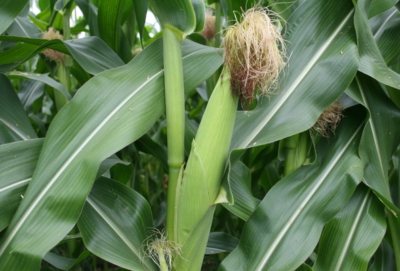

Large corn leaves have a linear-lanceolate shape, reaching 10 cm in width and 100 cm in length. One bush has from 8 to 42 leaf plates. Flowers are unisexual.At the top, panicle inflorescences are formed, which consist of male flowers, while female flowers are lower in the cobs, they are densely surrounded by a leaf.
Next, we will tell you what a ripe cereal looks like. Each ear can weigh 0.03 - 0.5 kg, grows in length up to 0.04 - 0.5 m. Traditionally there are 1-2 ears on one bush. In the upper part of them, pistillate columns are formed, where, with the help of the wind, pollen from male flowers enters and fertilization occurs. After that, large kernels are formed on the corn, which are fruits.
The shape of the grains is cubic or flat.
There can be up to 1000 kernels in one ear.
They can be of different colors:
- yellow;
- pale red;
- blue;
- purple;
- and even black.
Corn bloom is observed in late June, early July, but everything will depend on the region and weather conditions.
Views


Sugar maize fruits
There are only 8 types of cereals, while only 5 of them are of production value:
1. Sugar... It has received the widest distribution and is most often used in breeding due to the milky and sweet taste of the cobs. Mostly young grains are eaten.
2. Starchy... It is characterized by a high starch content and is also called flour or soft. It is used for the production of molasses and corn flour, it is very easy to process. The grains are large, white or red
3. Tooth-shaped... On the cob there are large, rich yellow grains. Differs in resistance to diseases and high yield. It is used as feed and industrial raw materials, but it is also used for food.
4. Indian... Another name is siliceous. An early ripening, starchy species, from the grains of which corn flakes and cereals are produced. A characteristic feature is grains of different sizes, which are white, light yellow and even almost black
5. Bursting... Mainly used in the food industry for the production of popcorn
6. Wax... Least valuable species. Possesses poor resistance to adverse influences and gives small yields. Grains are white and yellow, covered with a wax film
Another 2 types (filmy and sharp-grain) do not carry food or industrial value.
When to harvest corn
There are two types of maize ripeness: dairy and biological. When the milky ripeness is reached, the corn grains become soft, their color becomes light yellow. At the same time, it is still quite difficult to separate the leaves from the cob. Milky-ripe cobs with caryopses are best suited for boiling and canning. If the grain is intended for technical purposes or for processing, then you should wait until it is fully ripe. A ripe ear of corn is easily peeled of leaves, and the kernels in it have a bright rich yellow or orange color.
Description of the stages of cultivation on a personal plot
Growing the queen of the fields in the country begins with the choice of a variety or hybrid of a crop.
Choosing a variety or hybrid
There are many varieties and hybrids of corn. The variety is chosen based on the goals of cultivation: for fresh consumption, preparations for the winter or freezing.
Distinguish:
- Early varieties - Sundance, Gourmet 121 (pictured), Trophy F1, Landmark F1. They give a good harvest in a short time. Plants tolerate transplanting well and are often grown via seedlings. From the moment the sprouts appear to milk ripeness, an average of 65-89 days pass. They are used fresh (boiled).
- Mid-season varieties - Mermaid, Favorite, Pearl, Spirit F1. More resistant to adverse weather conditions. They sit for a month longer Suitable for fresh consumption, canning and freezing.
- Late varieties - Bashkirovets, Polaris, Russian bursting 3. The most productive, but also ripening varieties for a long time. Some specimens grow up to three meters in height. The ripening period lasts up to 150 days. Resistant to disease and lodging.Versatile to use.
Seed preparation
Corn is grown in two ways: by sowing seeds directly into open ground and through seedlings. The seedless method is less laborious, but does not allow an early harvest. Crops in this case are more resistant to the whims of nature.
One week before sowing the grains are heated at a temperature of + 35 ° C. Seed material is soaked and floating specimens are removed. Quality grain is wrapped in a wet cloth and kept wet until germination.
Before planting, the seeds are disinfected. from pests and diseases. To do this, they are soaked in a solution of potassium permanganate, aloe juice or preparations "Merkuran" or "Granozan".
Grain for seedlings is planted in plastic or peat cups... The diameter of one container is about 10-12 cm. The glasses are filled with a mixture of sod substrate and humus or compost in a 1: 1 ratio.
Prepared seeds are planted to a depth of 3-4 cm... Young plants are planted in a permanent place after a month.
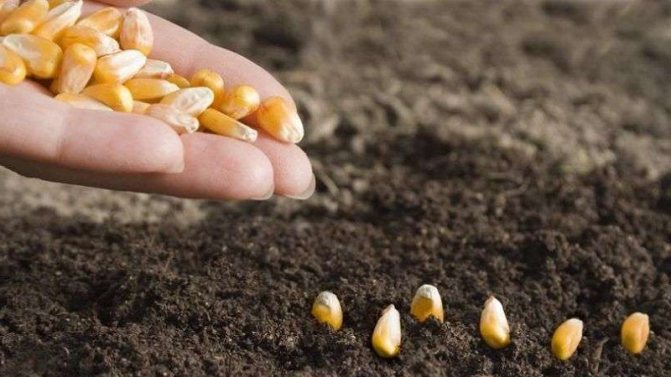

Soil preparation
Soil preparation begins in the fall and consists of harvesting predecessors, digging and fertilizing.
For sowing, choose a well-lit area, protected from cold winds. Corn loves fertile soil: black earth, loamy and sandy loam with good aeration and water permeability.
The best predecessors for corn are considered winter and spring cereals, legumes, cabbage, tomatoes, melons.
Important! Like all grains, corn absorbs a lot of nutrients from the soil, so it is not cultivated in the same place for more than two years in a row.
In the spring, the soil is loosened to the seeding depth... This will saturate the soil with oxygen, retain moisture and accelerate the emergence of germs.
Landing
Seeds are sown in open ground after the soil warms up to + 12-13 ° С... The landing pattern is determined based on the manufacturer's recommendations. On average, a distance of 50-60 cm is maintained between rows, and 30-40 cm between plants.
Seeds are embedded in prepared and moistened soil to a depth of 6-8 cm and sprinkled with earth.
When planting through seedlings, holes are prepared in advance a little more deep than a glass. Then the plants are watered and mulched.
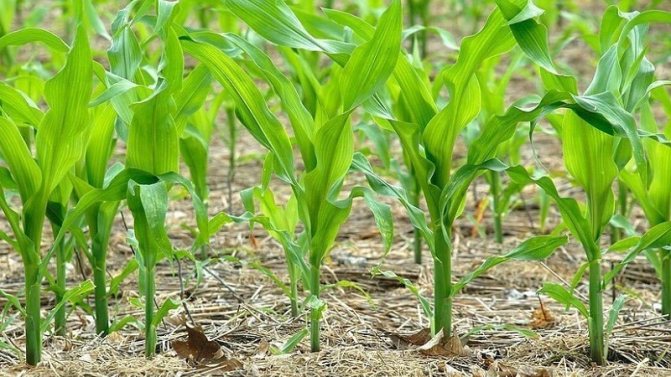

Care
Whatever you grow, it is important to properly care for the plantings... Caring for corn beds is reduced to watering, fertilizing, and protecting against pests and diseases.
How much water does crops need? The intensity of watering depends on the climatic conditions and the stage of plant growth.... The culture experiences the greatest need for moisture in the phase of development of 9-11 leaves, when the plant is actively increasing its green mass, and during the flowering period. Lack of moisture reduces the quantity and quality of the crop.
After watering, the soil is loosened, along the way, removing weeds... Loosening and weeding is especially important at the initial stage of plant development.
Top dressing is applied two times:
- the first - at the stage of formation of 3-4 leaves (organic fertilizer);
- the second time - at the stage of sweeping panicles (mineral).
Diseases and pests
Corn crops are susceptible to fungal diseases... The most dangerous of them are:
- Fusarium... It affects the cobs, stalks, young shoots. Reduces yield by half. It is characterized by the appearance of a pink coating on the cob. Subsequently, the grains darken and collapse. The disease spreads due to the high acidity of the soil, excess moisture, a drop in air temperature, and thickening of crops. As a result of the vital activity of the fungus, toxins accumulate in the tissues of the plant, which are dangerous for humans and animals.
- Rust... The causative agent of the infection becomes more active in July. Light yellow spots appear on the underside of the leaf, which eventually darken and become covered with pustules with fungal spores.
- Bubble smut... Fungal disease, accompanied by the appearance of neoplasms on foliage and ears. It develops due to prolonged drought.
For the prevention of fungal diseases seeds are treated with fungicides "Vitavax", "Vitalon", "Alios", etc. The working fluid is prepared in accordance with the instructions on the package.


Common pests in corn fields include:
- The wireworm is the larva of the click beetle. Loves high humidity. The larvae gnaw at the root system of plants and are able to completely destroy crops.
- The larvae of the scoop. Cotyledon leaves and young corn sprouts are devoured, as a result of which the plants stop growing and die.
Treatment of crops with insecticides "Kinfos", "Karate Zeon", "Tsiperus" and others helps to protect against pests. Spraying is carried out during the growing season:
- when the first wave of pests appears;
- in two weeks.
Working fluid consumption - 200-400 l / ha.
Preventive measures include observance of the rules of crop rotation, deep plowing in autumn, spring cultivation.
Harvesting and storage
The ears, intended for consumption in raw, boiled or canned forms, are harvested at the stage of milky ripeness. At this stage, the beans have a mild sweet taste. First, the heads of cabbage are removed, located closer to the top of the stem. They are the first to keep up.
The following signs indicate that the cobs are ready for harvest:
- the heads of cabbage deviated to the side;
- the panicle at the end of the ears began to dry out;
- the ears are completely filled with grains;
- the grains turned pale yellow;
- when pressed on the grains, a white liquid resembling milk is released.
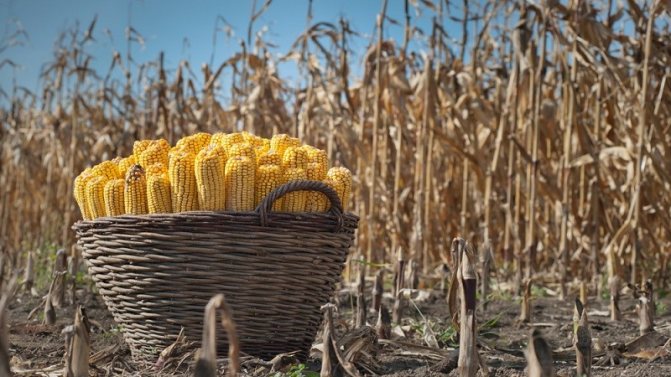

Delaying the harvest time leads to the fact that the fruits lose their juiciness and sweetness.and the grains become tough.
Once the ears are removed from the stalk, the sugars in the corn kernels begin to convert to starch.... Therefore, the harvested corn is eaten, canned or frozen for several days after harvest.
Planting different crops together
The plant perfectly coexists with other crops, while The best neighbors for maize are legumes: peas, beans, but also courgettes, sunflowers, pumpkins, melons, or potatoes. For these plants, maize serves as both a natural shelter and support. Buckwheat, melons and legumes are good precursors for cereals.
Corn and bean seeds can even be planted in the same hole, and then do not thin out the seedlings. This mutually beneficial neighborhood is built on the fact that maize obtains nitrogen from the soil, which beans produce. She, in turn, uses corn stalks as a support for growth.
Joint planting of cucumbers and corn
The same successful symbiosis of maize with cucumbers and pumpkin, which the corn protects from strong winds and prevents their fruits from lying on the ground. At the same time, the growing partner plants should not be allowed to overtake the cereal, creating unnecessary shading. It is not recommended to plant corn and tomatoes together.
Optimal planting after corn is legumes, beets, carrots, perennial greens or winter grains, leafy vegetables.
How to grow?
Next, the process of growing corn itself will be described.
Preparation and timing of sowing seeds
Regardless of how the corn is planted, the seeds are pre-prepared. Here are the stages of their preparation:
- The grains are sorted out, the damaged ones are immediately thrown away.
- For 4 days, the raw material is heated at a temperature of 35 degrees.
- For a day, the seeds are soaked in warm water. It is best to place them in a cloth bag and periodically dip them in water, or spray them with water. It is advisable to add wood ash to the water, which is an excellent growth stimulant.
It is necessary to plant seeds in open ground at temperatures of at least 10 degrees and in stable weather, when frosts are no longer expected.
Landing times will depend on the specific region, on average, they occur at the end of April-beginning of May. Seeds for seedlings are planted at about the same time, and after a month it can be transplanted into open ground.
Landing on a personal plot
There should be a half-meter gap between the rows. From one plant to another - 0.3 m. In the soil, holes are made about 7 cm deep. After that, seeds are planted, which are sprinkled first with wet and then dry soil. You will find instructions and recommendations on seeding rates, planting and crop care in this article.
We recommend watching a video on how to grow corn in the country:
Features for the Moscow region
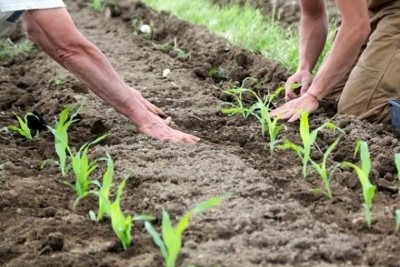

In this region, it is best to plant corn with seedlings. The best way to do this is to use plastic cups. The soil should be mixed with peat and humus.
After planting the seeds, they are watered and the soil is slightly compacted. After a week, shoots appear, excess shoots must be removed, leaving the strongest of them. Such thinning is necessary for the subsequent bountiful harvest. We described all the subtleties and nuances of growing corn in the Moscow region in a separate article.
For Siberia and the Urals
Since the weather in Siberia can be unpredictable, you need to be more conscious about growing corn. The vegetable species grows well here, as it is shorter and ripens earlier. Hybrids grow well.
- Landing dates in Siberia will be much later than in the middle lane. You need to wait until the soil warms up well. This time falls on the end of May-beginning of June.
- Landing is also carried out in the Urals:
- But here there are southern regions where you can plant corn in early May at 5-10 days.
- In the server parts of the region, you will have to wait 20-25 days. In this case, soil warming should not be less than +9 degrees.
3 seeds are planted in one hole, after their germination, the strongest sprout is left.
For the inhabitants of Siberia and the Urals, we have prepared articles in which you can learn how to get a rich corn crop in these regions.
Subtleties for sugar varieties
Sweet corn is a heat-resistant variety. In order for its seeds to germinate, you will need to warm up the earth to at least 10 degrees. If the temperature is in the range of 12-14 degrees, then the sprouts will appear already on the 12-14th day. And at 20-22 degrees - for 5-6 days.
So, the optimal temperature will be 22-25 degrees. But the culture does not tolerate frost. You will find practical advice on growing and a description of the best varieties of sweet corn in a separate material.
Can I plant with cucumbers?
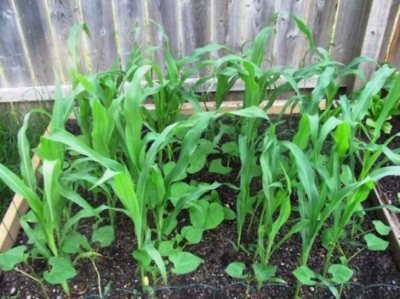

It is very useful to plant corn and cucumbers nearby, these plants have a lot in common:
- They are both thermophilic.
- They prefer abundant watering.
- They have the same predecessors.
- Requires similar mineral feeding.
The corn acts as a support for the cucumber. And the shade from the tall bushes will protect the vegetable from the bright sun and drafts. Cucumbers, due to the fact that they spread on the ground, do not allow the soil to dry out quickly, thereby the corn can stay without watering for some time. Fruiting times for both crops also increase.
The root system does not interfere with the neighbors, corn roots go deep underground, cucumbers have short roots.
Optimal growing conditions
Corn is considered a heat-loving, heat-resistant crop. Its seeds germinate at temperatures of 10 ° C and above. The optimum temperature for growth is between 22-25 ° C; in cold and hot weather, the growth processes of corn slow down.
The plant does not tolerate shade well and develops well with an abundance of sun. Corn also withstands drought relatively well. The largest yields can be obtained on fertile, weed-free, loose soil.
The culture is responsive to the introduction of organic and mineral fertilizers.
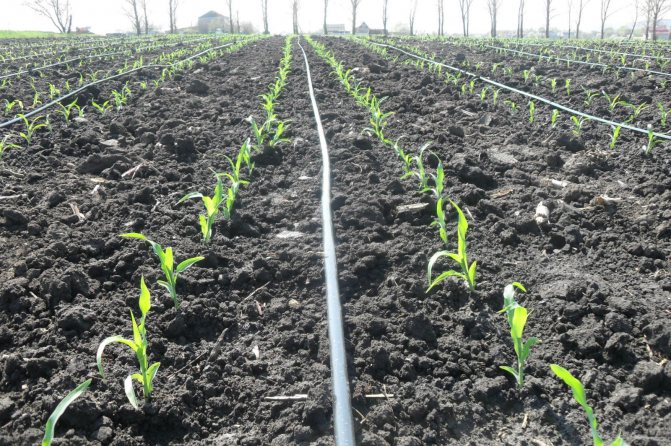

Planting corn
Note! A particularly large consumption of nutrients by plants occurs in the first phase of the growing season, before flowering.
If you re-grow corn on the same plot, you can also get a bountiful harvest, provided the soil is saturated with organic matter introduced in the previous year.
Pollination
Knotted ears
The planting yield of corn can be increased using artificial pollination technology. For this event, choose a calm, windless weather.
The technology is simple: the pollen from the bristles is shaken off onto the tying ears, or a soft brush is alternately passed over the female and male flowers.
Site selection
Corn kernels
Unpretentious culture and lighting - for stable growth, it has enough daylight hours - 12-14 hours. Meticulously it is worth approaching only the choice of soil: it should be quite fertile and loose.
Optimal for cereals is considered: loamy or sandy loam soil with weak or neutral acidity (from 5.5 to 7 pH). Good drainage is important so that water does not stagnate during irrigation, and groundwater does not come close to the soil surface.
If the soil on the site is not suitable, then it can be enriched with fertilization. The basic principles of increasing soil fertility, depending on the preparation period for planting cereals, are collected in the table.
| Time spending | The essence of the technique |
| In the fall before the next season | Dig up with the introduction of humus or compost at the rate of 1 full bucket per 1 m2 |
| 1 month before planting | Add 0.5 kg of dolomite flour or 3 times more wood ash to the soil |
| For 10-14 days | The soil should be weeded out and a complex mineral mixture should be added |
| During landing | 0.5 kg of humus is introduced into each hole |
The plant needs protection from the cold wind, therefore, it is better to plant it under the protection of large trees or near buildings.
What is the best way to grow corn after?
For corn, it is not so much the predecessors that are important as the quality of the soil and the timing of planting. But under the same conditions, the highest corn yields are harvested from the fields where they were grown:
- melons and gourds;
- legumes;
- potatoes,
- table, sugar or fodder beets;
- ears and grain crops.
In arid regions, corn is not planted after beets and sunflowers - these crops especially dry out and deplete the soil.
In ordinary vegetable gardens, corn can be grown for several years in one place.
The predecessors not acceptable for corn are millet and sorghum. All three crops have the same diseases and pests.
Soil and seed preparation
For this culture, at your dacha, you need to choose a sunny area that is well protected from the wind. It is better to plan the garden so that legumes and pumpkins are grown along with corn. Peas and beans will saturate the soil well with the nitrogen necessary for corn, and wide pumpkin leaves will cover its roots and protect it from overheating.
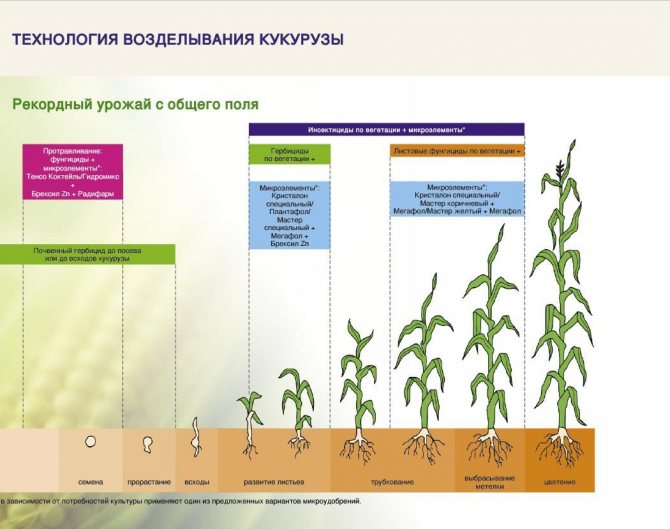

Sowing dates
How to plant corn in a vegetable garden
The soil should be well warmed up, with a high rate of water and air permeability, as well as a significant humus content. Mineral and organic fertilizers are introduced into the garden in advance.
Note! The best precursors for corn are tomatoes, potatoes, cabbage, and legumes.
Since the future harvest directly depends on the quality of the seed, the largest seeds should be selected for planting without damage. The next step is to pickle the grains in order to get rid of pathogens of various diseases. To do this, you can use a weak solution of potassium permanganate, hydrogen peroxide, industrial pesticides. Another method of disinfection involves alternately placing corn kernels in hot and cold water.
Soil for planting corn
Corn is a sun-loving, heat-loving crop. Differs in unpretentious care. However, in order to produce a healthy plant with rich fruiting, corn should be grown in the following types of soil:
- sandy loam;
- loamy;
- peat;
- with a neutral reaction;
- slightly acidic.
Fresh articles for gardeners, gardeners and florists
Ammonium in the garden use for strawberries
Top dressing of tomato and pepper seedlings with folk remedies
Lunar sowing calendar for 2019 gardener and gardener table
Pruning raspberries in the spring how to do it right
Corn can also be grown on poor, acidic and podzolic soils, if you take into account the recommendations of experienced gardeners:
- From autumn, add humus or compost to the soil on the site with the calculation of one bucket of organic matter per m2.
- In the spring, a month before planting, add dolomite flour and wood ash to the soil. For each square meter of planting, 500 g of dolomite flour and 1.5 kg of wood ash are added.
- 2 weeks before planting, the soil should be weeded out and a complex mineral fertilizer should be applied.
- Before planting, 400-500 g of humus must be added under each plant.
The above recommendations will allow you to change the structure of the soil, namely, to reduce the acidity of the soil to a neutral reaction, the soil will become loose and fertile.
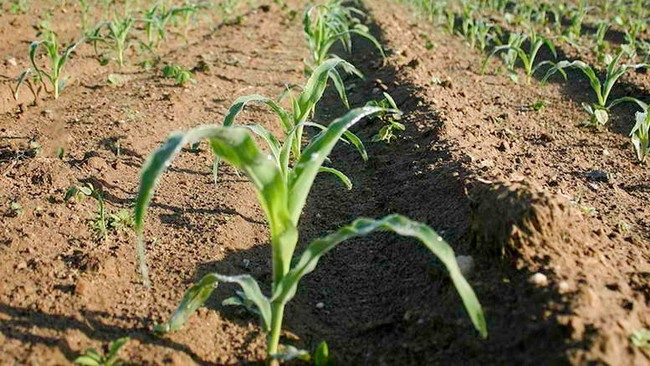

Suitable varieties for different regions
Depending on the weather and climatic conditions of growth, for each specific region, different varieties are chosen with different indicators of resistance and germination.
So, in Siberia with a harsh continental climate, the cultivation of maize varieties will be successful: Spirit, Khutoryanka, Gourmet 121, Epic, Jubilee. These varieties withstand harsh weather changes and cold winds, and ripen faster.
Sugar corn KHUTORYANKA
For the Moscow region, it is better to select varieties of early ripening, which are better planted with seedlings. A balanced choice will be the varieties: Gourmet Belogoria, Triple Joy, Anava, Spirit.
Sugar corn Gourmet Belogoriya
In central Russia and the Urals, a good harvest can be harvested by planting a plant of varieties: Pioneer of the North, White Night and Tiraspolskaya-33.
Sweet corn Spirit
In the Leningrad region, temperatures above +10 degrees are less frequent than necessary for the full ripening of maize, therefore, the cobs in this region must be harvested in a state of milky ripeness. The early ripening varieties will be the best choice: White Night, Early Pearl, Firstborn, Early Sugar.
Sugar corn Early Gourmand
For cultivation in Turkmenistan, special zoned varieties were bred: Annau-62 and Paitagt.
Khmelnitsky variety
Maize hybrids bred for Ukraine are distinguished by high yield potential (on average 15 t / ha) and resistance to negative environmental influences... These are: Dneprovsky, Khmelnitsky, Baturin, Sinevir, Dnipro, Kvitnevy, Solonyansky, Orzhitsa.
Dneprovsky variety
Zoned varieties of sweet corn in Belarus: Brusnitsa, Almaz, Lyudmila, Porumbel, Competitor.
Maize variety Porumben
The main varieties and varieties of corn: a detailed description
Corn is an annual plant belonging to the cereal family. It has a very strong fibrous root, which spreads quite widely in the soil (1.5-2 m around). The stalk of corn is straight, with knots, and can reach a height of several meters. On the lower nodes there are light aerial roots, which serve as a kind of stabilizer for the massive upper part of the plant, on which the fruits ripen. The leaves of corn are quite large - about 10-15 cm wide and can reach one meter in length. The plant contains both female and male inflorescences (panicles). The latter are located in the lower part of the stem, and the former are located at the ends of young ears. Pollen from panicles is carried by the wind and falls on spikelets located at the ends of the ears.
Corn grain is rich in vitamins and minerals. Female flowers of corn excrete bile, stimulate the work of the pancreas and liver, as well as the digestive tract. Corn seeds contain a large amount of B vitamins, flavonoids, niacin, etc. Corn oil is a good vessel cleaner, as it removes excess cholesterol.
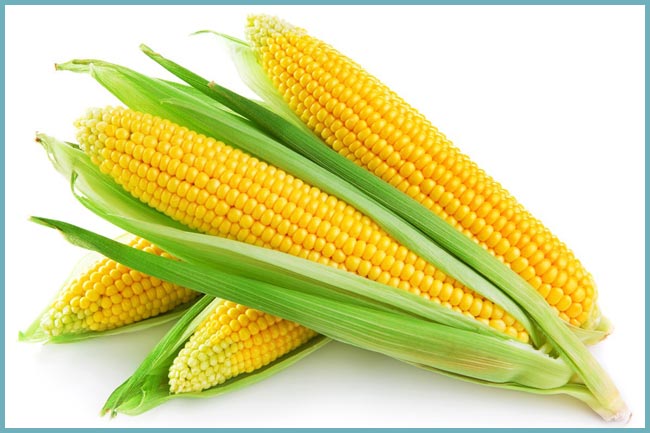

Corn is good for both children and adults
Today, there are about ten main varieties of corn, depending on the structure of the cobs and use: sugar, tooth-like, flint, starchy, bursting, waxy, etc. All these varieties, except for the first, are used only for industrial purposes: for the production of starch, flour, alcohol, molasses, cereals, everyone's favorite corn sticks, etc.
Consider the varieties of sweet corn that best adapt to unfavorable growing conditions:
- Sundance. An early variety with fairly large ears. Two fruits ripen on one plant. Grains are light yellow in color. Suitable for growing in cold regions. It is used boiled, but also great for preservation.
- Spirit. This variety perfectly adapts to almost any climate, so it can be grown everywhere in Russia. The hybrid is quite new, has ears with bright yellow grains of a delicate sweet taste.
- Dobrynya. Early variety. The ears grow quite large and taste sweet. It is unpretentious to the soil on which it is planted, it is resistant to diseases. Used in food in any form.
- Swift. Unusual variety. The plant is dwarf, with early ripening ears, very sweet in taste.
- Triple sweetness. A very unpretentious variety for growing conditions. As the name implies, the ears are exceptionally sweet and delicate.
Description of the plant
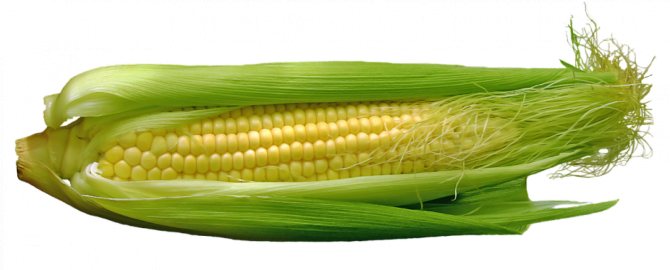

Corn
Herbaceous annual - corn or maize - refers to cereals, but is considered a cereal. The homeland of the plant is the region of modern Mexico and Peru; it came to Russia only in the 18th century during the Russian-Turkish war. Initially, the culture was grown in the southern regions of the Russian Empire.
Unlike other cereals, corn has developed and multi-tiered root and aerial parts. Depending on the variety, individual plants can grow up to 7 meters. Long leaves protect the inflorescence - ear and panicle. The monoecious plant has male flowers (can be identified by the presence of stamens) and female (there are only pistils).
The plant is so cultivated that corn no longer grows in the wild.
Despite the fact that corn is considered a southern, heat-loving crop, it is also grown in northern latitudes (by the seedling method), because seed ripening begins at +10 degrees. At the same time, seedlings can even safely tolerate short frosts.
Maize is a valuable food crop
The growing season of maize takes 3 to 5 months. During this time, the plant forms 1–2 ears, the average weight of which reaches 500 g, and the length is 40–45 cm.
Where is the best place to place a plant in a country house, in a vegetable garden, in a garden or in a field?
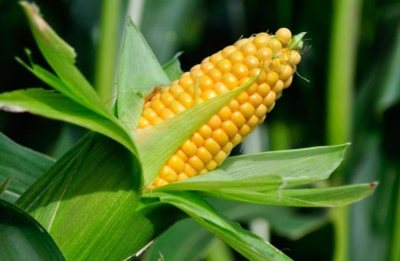

It is known that the culture is quite thermophilic. There are maize varieties that tolerate the temperate climate and even Siberian conditions quite favorably.
If you choose the right place for landing, then half the job will be done. To do this, you need to choose an open ground, and it should be well lit at the same time. If there is not enough light and heat, corn will develop slowly, and the grains will not even gain milk ripeness.
Corn does not tolerate cold winds and drafts, so protection will need to be erected. This could be a fence at the far end of the site.
Thus, we can conclude that an open field for planting corn is not the best option, but a large area with a fence is the best solution.
Further care
Regular watering is essential for proper maintenance, as corn is a moisture-loving crop. One seedling "drinks" 2–4 liters of water per day. But excess moisture and its stagnation in the soil can destroy the roots of plants, so you need to water the crop regularly and in moderation.
During dry periods, the frequency of watering increases, especially during flowering and ear formation.Drip irrigation is the best irrigation method that provides optimal soil moisture.
You may be interested in learning how to peel corn quickly and correctly.
The corn needs not only to be "watered", but also "fed". One-time pre-sowing soil fertilization will not be enough. You need to feed the seedlings throughout the season: from emergence to fruiting. The composition of the fertilizer should differ depending on the stage of plant development: nitrogen is applied until the formation of grains on the cobs, potassium - in the first half of the growing season, and phosphorus is needed all the time.
There is a need for other elements as well: manganese, zinc, copper and boron. Maize also loves organic fertilizers, which are applied at the stage of 3-4 leaves: a solution of cow dung (1:10) or chicken manure (1:20). After half a month, you can switch to mineral fertilizing (dosage according to instructions).
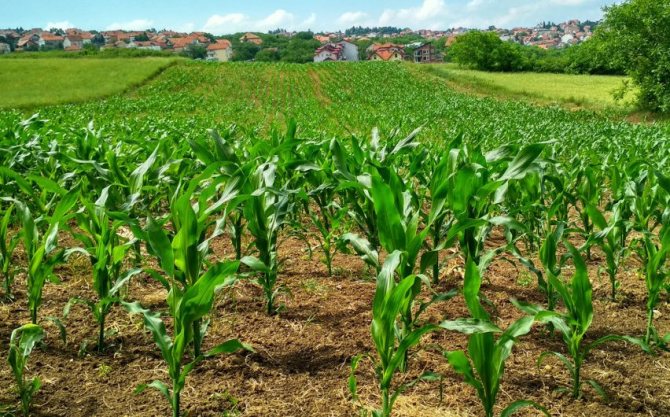

Hilling and removing weeds
Weeds are serious enemies of corn, which can cause a 70% drop in yield.
- Harm from weeds:
- The "neighbors" of corn are also important. Experienced gardeners have noticed that it grows well with cucumbers.
- takes nutrients from the soil necessary for the development of culture;
- clogs the ground, preventing moisture and air from reaching the roots of the maize.
To control weeds on large plantings, special herbicides are used. In small areas, the classic method remains relevant - weeding. You need to start weeding after the emergence of corn shoots. Then this must be done after each watering and rain.
- Regular weeding achieves the following goals:
- destruction of weed shoots and roots;
- preservation of moisture in the ground;
- loosening the soil to improve the access of moisture and air to the roots.
Hilling seedlings is also a necessary step. It should be done while weeding after rain. Each bush is covered with earth to a height of 8-10 cm. Due to this, aerial roots are formed in the sprouts, which serve as an additional strengthening of the stems and contribute to an increase in yield.
Disease and pest control
Although maize is a fairly sturdy plant, it is vulnerable to several diseases and harmful insects.
Diseases include the following:
Fusarium - affects the cobs, covering them with a pink coating and destroying the grains. Favorable environment: wet weather during the rainy season. From infected seeds, diseased shoots grow, doomed to death. It is impossible to cure a plant from this disease, but it can be prevented. For prevention purposes, it is necessary to treat the grain with any fungicide before sowing, observe the sowing time and sow the seeds only in warm soil.
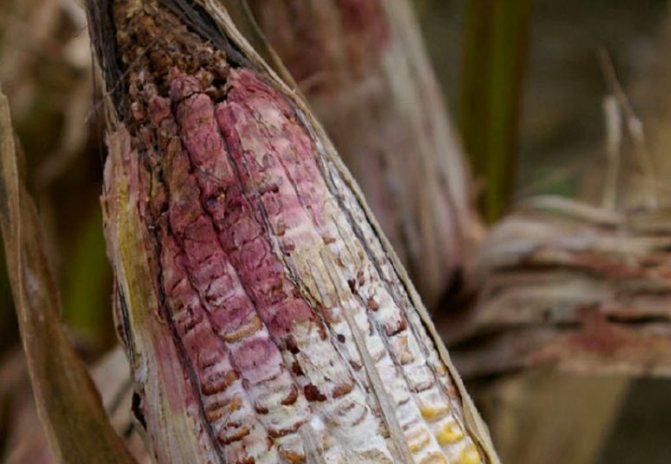

Helminthosporiosis - gray-brown spots on leaves and cobs, which grow and gradually destroy the entire plant. A diseased bush must be removed from the site to protect the rest of the plants. Prevention: treatment of grains and soil with fungicides before sowing, cleaning all corn residues from the garden after harvest and observing the correct crop rotation.
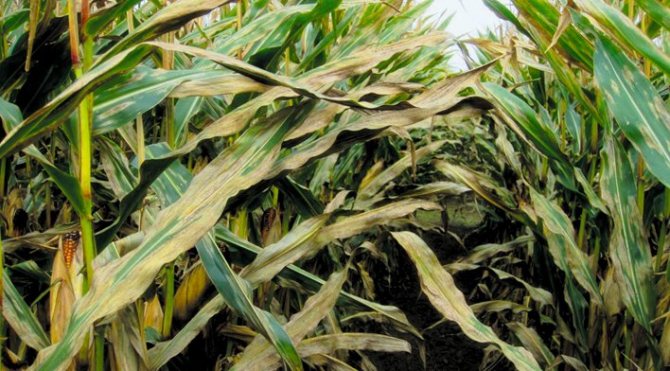

Dusty smut - a fungal infection that can "sleep" in the ground for several years, and under favorable conditions, manifest itself. It attacks inflorescences and ears, turning them into black dusty lumps. This is an aggressive disease that can kill almost half of the entire planting. To save the entire crop, you need to destroy the diseased plant in time. Prevention: choose disease-resistant varieties for sowing and follow the rules of crop rotation.
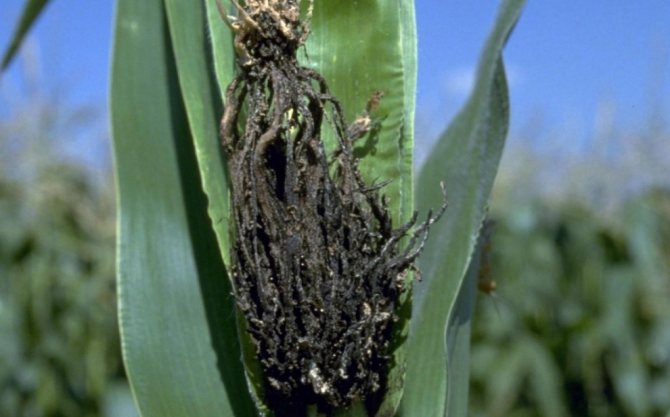

Bubble smut - a fungal disease in which blistery growths appear on the leaves, stems, ears and inflorescences. Favorable conditions: drought and dense planting. Prevention: plant resistant varieties, process the grain before planting, sow according to the correct scheme, after harvesting, remove the remnants of corn and weeds from the garden.
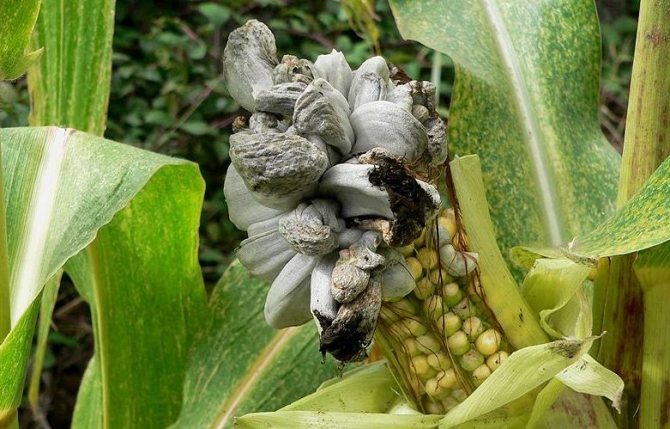

As for pests, corn can be annoyed by:
- corn moth;
- scoop;
- swedish fly;
- cereal aphid;
- wireworm.
As a preventive measure against the appearance of pests, the following measures should be taken:
- in the fall, plow deeply or dig up the ground;
- treat seeds with fungicidal preparations;
- adhere to crop rotation;
- timely destroy weeds.
Pest control methods:
- use of insecticides against adult insects;
- the use of pheromone traps against larvae.
Sowing dates
If you sow corn at a temperature of 8-10 ° C, seed germination will be long. Seedlings will be uncooperative, crops may get sick or mold. During a prolonged cold spring with early sowing, plantings will be sparse, frail, and will be late.
How to plant corn seedlings outdoors
In the case of late sowing, another threat arises. In the northern regions, the harvest will not have time to ripen, and in the southern regions, tender shoots can be dried up by the hot sun. When it is better to sow corn has long been determined by agricultural technicians. The optimal sowing time is determined by the soil temperature at the seeding depth. The thermometer in this layer of soil should show when measuring 10-12 ° C.
On a note! In the north, maize sowing dates coincide with cherry blossoms, and in the southern regions, crops are sown when apricots bloom.
In the spring of 2019, it was possible to plant corn according to the lunar calendar:
- from 19 to 27 April;
- from 18 to 26 May;
- June 16-25;
- from 16 to 24 July.
In cold regions, it is recommended to sow crops by seedling, embedding grains in peat cups. The use of just such a container for sowing at home is due to the fact that the roots of the plant are susceptible to transplantation and it is better not to disturb them once again.
When to plant corn seedlings? Favorable numbers for this in March will be days from 21 to 27 and in April from 19 to 27.
Advice! Planting corn at intervals of 15-20 days will allow you to get a continuous flow to the table.
Auspicious days for landing according to the lunar calendar 2019
Maize bed
Sowing and planting corn in 2019 in accordance with the lunar calendar will be successful from May 7 to May 9garden work on May 5 and 19 should be avoided. In June, you can do maize on 5, 6, 13, it is worth refraining from work - 6 and 17.
In July, a favorable period for work is 3, 11, 16. Unfavorable - 2 and 17. Late varieties in August can be practiced on 6 and 8, avoiding gardening is 1, 13, 15.
What to do with corn stalk and leaves after harvest
Growing corn in the country will not only allow you to get a harvest of tasty and healthy grains, but also provide you with a large amount of multifunctional material. The green stems and leaves after harvest are used to prepare silage (animal feed).
The dried stem has a very strong structure - it can be used to build temporary fences. And the leaves are used as a covering material for plants.
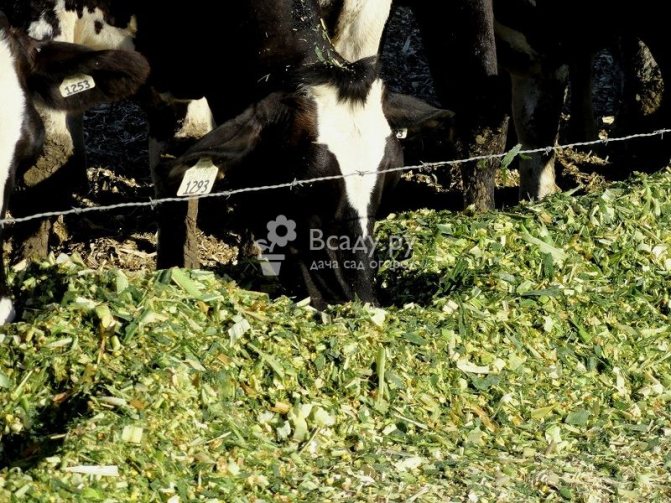

Corn leaves and stems are suitable for silage preparation
Tying tree boles with dry stems for the winter will protect the bark from animals. Tying corn trunks to young trees makes them more resistant to strong winds.
Useful tips for novice farmers
Experienced gardeners give recommendations to beginners:
- Remove the side shoots from the corn to prevent the plant from wasting energy on them. Then the cobs will be large.
- To prevent half-empty ears from growing, do not plant corn in one row, the minimum number of rows is two.
- Do not allow the soil to dry out during flowering, otherwise the stigmas will lose their ability to pollinate.
- When the corn blooms, shake it so that the pollen quickly gets from the male flowers to the female ones.
Corn is a unique crop, its versatility and ability to adapt to different climatic conditions are simply amazing. The agricultural technology for growing it in the open field is simple and does not require much effort.It is more difficult to grow corn with seedlings, but this is quite possible if you use early varieties and hybrids, and strictly follow the requirements of the seedling method.
0

